Paul van Yperen's Blog, page 339
July 22, 2016
Maria Perschy
Austrian actress Maria Perschy (1938-2004) was the sexy leading lady of many European films of the late 1950s before she made a short career in Hollywood in films by John Huston and Howard Hawks. In the 1970s she appeared in Spanish and Italian low-budget horror films and became a cult figure.
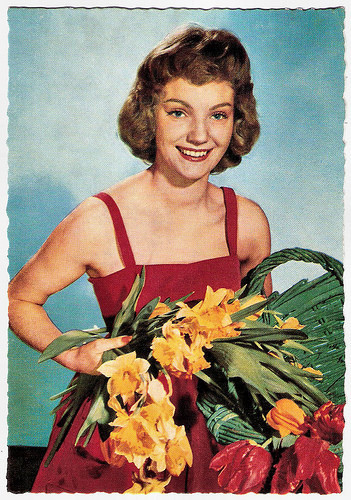
German postcard by WS-Druck, Wanne-Eickel, no. F 99. Photo: Klaus Collignon.
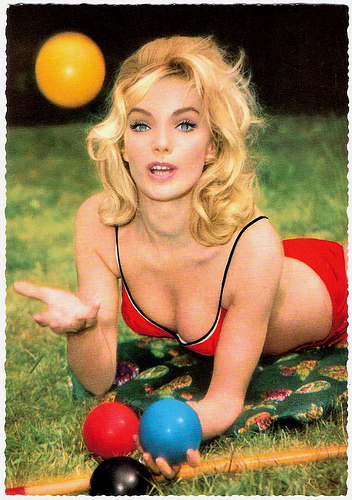
German postcard by Krüger, no. 902/376. Photo: Lothar Winkler.
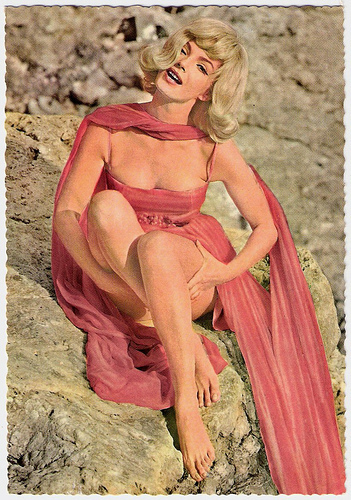
German postcard by Krüger, no. 902/403. Photo: Lothar Winkler.
Breeding for the Fatherland
Herta-Maria Perschy was born in 1938 in Eisenstadt, Austria in 1938. She moved to Vienna at the age of 17 to study acting at the prestigious Max Reinhardt Seminar. There she was awarded with the Kunstförderungspreis für Darstellende Kunst der Stadt Wien, an award of the city of Vienna to stimulate young and talented actors.
During her studies, the gorgeous and appealing brunette knockout made her film début with a small role in Roter Mohn/Red Poppy (Franz Antel, 1956) starring Joachim Fuchsberger . After finishing her studies, her teacher Susi Nicoletti helped to get her a contract at the Bavaria Filmstudios in Germany.
Her first major success came with Nasser Asphalt/Wet Asphalt (Frank Wisbar, 1958). In this Film Noir about the dangers of tabloid reporting, she starred opposite the young Horst Buchholz .
Soon this success was followed by films like Der Schwarze Blitz/The Black Lightning (Hans Grimm, 1958) with former ski champion Toni Sailer , Die Landärztin vom Tegernsee/Lady Country Doctor (Paul May, 1958), with Marianne Koch , Natürlich die Autofahrer/Of Course the Drivers (Erich Engels, 1959) with comedian Heinz Erhardt, and Der Held meiner Träume/The Hero of My Dreams (Arthur Maria Rabenalt, 1960) with Carlos Thompson .
Another commercial success was the clichéd drama Lebensborn/Fountain of Life (Werner Klingler, 1960), loosely based on the super-race propagation plan by Nazi Heinrich Himmler, which recruited men and women for their fair skin, blond hair, and blue eyes alone. These specially selected Aryans were ordered to breed, for the Fatherland.
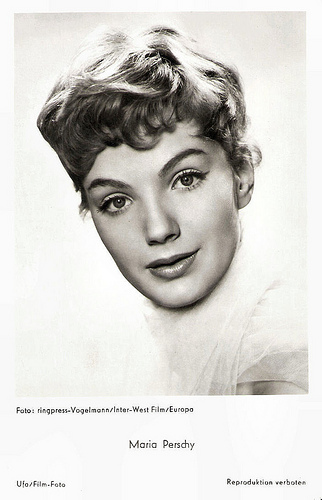
German postcard by Ufa, Berlin-Tempelhof, no. FK 3984. Photo: Ringpress / Vogelmann / Inter-West Film / Europa.
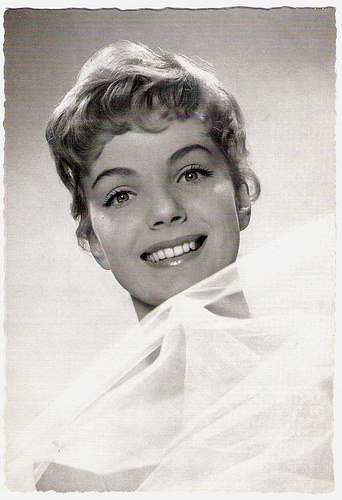
German postcard by WS-Druck, Wanne-Eickel, no. 287. Photo: Europa / Ringpress / Vogelmann.
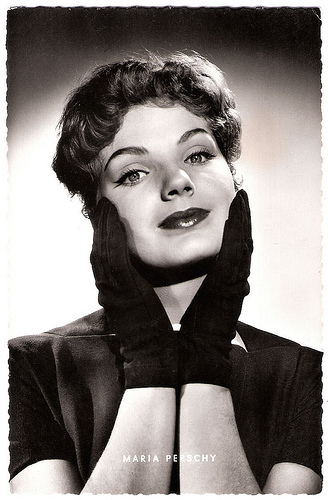
German postcard by Kunst und Bild, Berlin-Charlottenburg, no. A 1546.
Kiss Kiss, Kill Kill
Her acting career would eventually take Maria Perschy to France, Italy, Great Britain and Hollywood. Among her European films were Il Moralista/The Moralist (Giorgio Bianchi, 1959), I Piaceri del sabato notte/Call-Girls (Daniele D'Anza, 1960) with Pierre Brice , Un Amore a Roma/Love In Rome (Dino Risi, 1960) with Mylène Demongeot , and The Password Is Courage (Andrew L. Stone, 1962) starring Dirk Bogarde .
Hal Erickson writes at AllMovie about her short Hollywood career: "Like many attractive European actresses, Perschy tended to be shunted into sexpot roles in her English-language films: her character name in Howard Hawks' Man's Favorite Sport (1964), for example, was 'Easy.' By far, her best non-European film assignment was the part of Magda in John Huston's Freud (1962)."
In this biopic the pioneering psychotherapist himself was played by Montgomery Clift, and Rock Hudson was her leading man in the comedy Man's Favorite Sport?. She also appeared with Cliff Robertson in the routine war film Squadron 633 (Walter Grauman, 1964) and the South-African adventure African Gold (David Millin, 1965).
Perschy lived in Spain and played in Hollywood and in European productions, both films and TV-series. In Germany she appeared in the Edgar Wallace Krimi Der Henker von London/The Mad Executioners (Edwin Zbonek, 1963) with Hansjörg Felmy , as partner of Horst Frank in the Thriller Weiße Fracht für Hongkong/Mystery of the Red Jungle (Helmut Ashley, Giorgio Stegani, 1964) and in the Sci-Fi adventure Der Chef wünscht keine Zeugen/No Survivors, Please (Hans Albin, Peter Berneis, 1964).
Later followed adventure films and Westerns like Die Banditen vom Rio Grande/The Bandits of the Rio Grande (Helmuth M. Backhaus, 1965) with Harald Leipnitz, Kommissar X – Jagd auf Unbekannt/Kiss Kiss, Kill Kill (Gianfranco Parolini, 1966), Mister Dynamit – morgen küsst Euch der Tod/Die Slowly, You'll Enjoy It More (Franz Josef Gottlieb, 1967) with Lex Barker , and The Castle of Fu Manchu (Jesus Franco, 1969), featuring Christopher Lee .
Her last big film success in Germany was the comedy Dr. med. Fabian – Lachen ist die beste Medizin/Dr. Fabian: Laughing Is the Best Medicine (Harald Reinl, 1969) in which she starred opposite Hans-Joachim Kulenkampff.
In those years she had longtime relationships with actor Joachim Hansen – her co-star of Lebensborn - and later with skier Roger Staub.
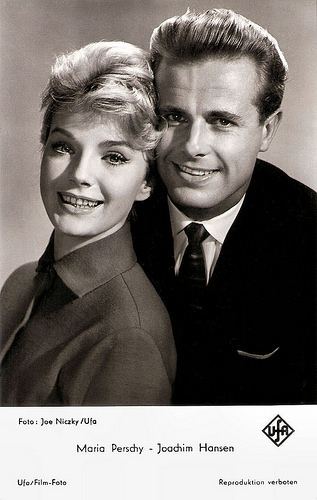
German postcard by Ufa, Berlin-Tempelhof, no. FK-4797. Photo: Joe Niczky / Ufa. Publicity still for Lebensborn/Ordered to Love (Werner Klingler, 1961) with Joachim Hansen .
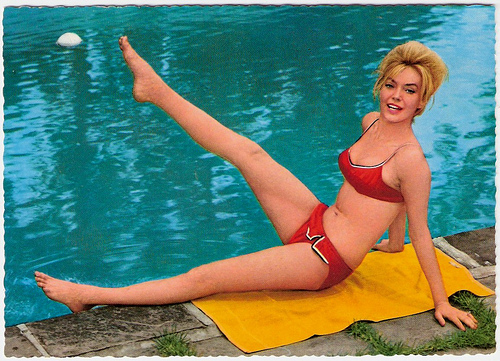
German postcard by Krüger, no. 902/373. Photo: Bernard of Hollywood.
Low-grade Horror Films
While shooting in Spain in 1971, Maria Perschy's face was burned severely by an accidental fire which required several operations. She was bedridden for an extended period before she could resume her career.
In Italy and Spain she appeared in many low-grade horror films, including El Buque Maldito/Ghost Galleon (Amando De Ossorio, 1974) and the Spanish rip-off of The Exorcist, Exorcismo (Paul Naschy aka Jacinto Molina, 1964). These films made her a kind of cult figure.
In 1976 the Spanish state pressed her to get a Spanish passport, Perschy choose to return to her native Austria. She did not stay long though. From 1977 on she lived in Los Angeles and was married to a writer.
By then her career in America petered out. She only appeared on TV in the daytime soap General Hospital (1977) and as a guest star in Hawaii Five-O (1978), a detective series starring Jack Lord as the head of a special state police unit answering only to the Governor of Hawaii.
For a while she worked as a translator ans she also worked in the antique retail. Her husband committed suicide in 1983 and she returned again to Austria in 1985.
She performed in stage plays such as A. R. Curney's Love Letters and the mystery play Witness for the Prosecution by Agatha Christie in Austria, Germany and Switzerland. She continued to play in TV series like the popular Krimi Tatort (1998) and Rosamunde Pilcher (1998).
Her last feature films were the low-budget shocker Vultures (Paul Leder, 1983) starring Stuart Whitman, and the romantic comedy Eine Frau namens Harry/Harry and Harriet (Cyril Frankel, 1990).
In 2004 Maria Perschy died of cancer in Vienna. She was 66. She had been married twice and had one daughter.
American trailer for Lebensborn/Ordered to Love (1961). Source: Video Detective (YouTube).
Trailer for Squadron 633(1964). Source: Michael Appert (YouTube).
Trailer Freud (1962). Source: Cliff Held (YouTube).
El buque maldito/Ghost Galleon (1974). Source: 2ombieboy (YouTube).
Sources: Stephanie d’Heil (Steffi-line), Hal Erickson (AllMovie), Wikipedia and .

German postcard by WS-Druck, Wanne-Eickel, no. F 99. Photo: Klaus Collignon.

German postcard by Krüger, no. 902/376. Photo: Lothar Winkler.

German postcard by Krüger, no. 902/403. Photo: Lothar Winkler.
Breeding for the Fatherland
Herta-Maria Perschy was born in 1938 in Eisenstadt, Austria in 1938. She moved to Vienna at the age of 17 to study acting at the prestigious Max Reinhardt Seminar. There she was awarded with the Kunstförderungspreis für Darstellende Kunst der Stadt Wien, an award of the city of Vienna to stimulate young and talented actors.
During her studies, the gorgeous and appealing brunette knockout made her film début with a small role in Roter Mohn/Red Poppy (Franz Antel, 1956) starring Joachim Fuchsberger . After finishing her studies, her teacher Susi Nicoletti helped to get her a contract at the Bavaria Filmstudios in Germany.
Her first major success came with Nasser Asphalt/Wet Asphalt (Frank Wisbar, 1958). In this Film Noir about the dangers of tabloid reporting, she starred opposite the young Horst Buchholz .
Soon this success was followed by films like Der Schwarze Blitz/The Black Lightning (Hans Grimm, 1958) with former ski champion Toni Sailer , Die Landärztin vom Tegernsee/Lady Country Doctor (Paul May, 1958), with Marianne Koch , Natürlich die Autofahrer/Of Course the Drivers (Erich Engels, 1959) with comedian Heinz Erhardt, and Der Held meiner Träume/The Hero of My Dreams (Arthur Maria Rabenalt, 1960) with Carlos Thompson .
Another commercial success was the clichéd drama Lebensborn/Fountain of Life (Werner Klingler, 1960), loosely based on the super-race propagation plan by Nazi Heinrich Himmler, which recruited men and women for their fair skin, blond hair, and blue eyes alone. These specially selected Aryans were ordered to breed, for the Fatherland.

German postcard by Ufa, Berlin-Tempelhof, no. FK 3984. Photo: Ringpress / Vogelmann / Inter-West Film / Europa.

German postcard by WS-Druck, Wanne-Eickel, no. 287. Photo: Europa / Ringpress / Vogelmann.

German postcard by Kunst und Bild, Berlin-Charlottenburg, no. A 1546.
Kiss Kiss, Kill Kill
Her acting career would eventually take Maria Perschy to France, Italy, Great Britain and Hollywood. Among her European films were Il Moralista/The Moralist (Giorgio Bianchi, 1959), I Piaceri del sabato notte/Call-Girls (Daniele D'Anza, 1960) with Pierre Brice , Un Amore a Roma/Love In Rome (Dino Risi, 1960) with Mylène Demongeot , and The Password Is Courage (Andrew L. Stone, 1962) starring Dirk Bogarde .
Hal Erickson writes at AllMovie about her short Hollywood career: "Like many attractive European actresses, Perschy tended to be shunted into sexpot roles in her English-language films: her character name in Howard Hawks' Man's Favorite Sport (1964), for example, was 'Easy.' By far, her best non-European film assignment was the part of Magda in John Huston's Freud (1962)."
In this biopic the pioneering psychotherapist himself was played by Montgomery Clift, and Rock Hudson was her leading man in the comedy Man's Favorite Sport?. She also appeared with Cliff Robertson in the routine war film Squadron 633 (Walter Grauman, 1964) and the South-African adventure African Gold (David Millin, 1965).
Perschy lived in Spain and played in Hollywood and in European productions, both films and TV-series. In Germany she appeared in the Edgar Wallace Krimi Der Henker von London/The Mad Executioners (Edwin Zbonek, 1963) with Hansjörg Felmy , as partner of Horst Frank in the Thriller Weiße Fracht für Hongkong/Mystery of the Red Jungle (Helmut Ashley, Giorgio Stegani, 1964) and in the Sci-Fi adventure Der Chef wünscht keine Zeugen/No Survivors, Please (Hans Albin, Peter Berneis, 1964).
Later followed adventure films and Westerns like Die Banditen vom Rio Grande/The Bandits of the Rio Grande (Helmuth M. Backhaus, 1965) with Harald Leipnitz, Kommissar X – Jagd auf Unbekannt/Kiss Kiss, Kill Kill (Gianfranco Parolini, 1966), Mister Dynamit – morgen küsst Euch der Tod/Die Slowly, You'll Enjoy It More (Franz Josef Gottlieb, 1967) with Lex Barker , and The Castle of Fu Manchu (Jesus Franco, 1969), featuring Christopher Lee .
Her last big film success in Germany was the comedy Dr. med. Fabian – Lachen ist die beste Medizin/Dr. Fabian: Laughing Is the Best Medicine (Harald Reinl, 1969) in which she starred opposite Hans-Joachim Kulenkampff.
In those years she had longtime relationships with actor Joachim Hansen – her co-star of Lebensborn - and later with skier Roger Staub.

German postcard by Ufa, Berlin-Tempelhof, no. FK-4797. Photo: Joe Niczky / Ufa. Publicity still for Lebensborn/Ordered to Love (Werner Klingler, 1961) with Joachim Hansen .

German postcard by Krüger, no. 902/373. Photo: Bernard of Hollywood.
Low-grade Horror Films
While shooting in Spain in 1971, Maria Perschy's face was burned severely by an accidental fire which required several operations. She was bedridden for an extended period before she could resume her career.
In Italy and Spain she appeared in many low-grade horror films, including El Buque Maldito/Ghost Galleon (Amando De Ossorio, 1974) and the Spanish rip-off of The Exorcist, Exorcismo (Paul Naschy aka Jacinto Molina, 1964). These films made her a kind of cult figure.
In 1976 the Spanish state pressed her to get a Spanish passport, Perschy choose to return to her native Austria. She did not stay long though. From 1977 on she lived in Los Angeles and was married to a writer.
By then her career in America petered out. She only appeared on TV in the daytime soap General Hospital (1977) and as a guest star in Hawaii Five-O (1978), a detective series starring Jack Lord as the head of a special state police unit answering only to the Governor of Hawaii.
For a while she worked as a translator ans she also worked in the antique retail. Her husband committed suicide in 1983 and she returned again to Austria in 1985.
She performed in stage plays such as A. R. Curney's Love Letters and the mystery play Witness for the Prosecution by Agatha Christie in Austria, Germany and Switzerland. She continued to play in TV series like the popular Krimi Tatort (1998) and Rosamunde Pilcher (1998).
Her last feature films were the low-budget shocker Vultures (Paul Leder, 1983) starring Stuart Whitman, and the romantic comedy Eine Frau namens Harry/Harry and Harriet (Cyril Frankel, 1990).
In 2004 Maria Perschy died of cancer in Vienna. She was 66. She had been married twice and had one daughter.
American trailer for Lebensborn/Ordered to Love (1961). Source: Video Detective (YouTube).
Trailer for Squadron 633(1964). Source: Michael Appert (YouTube).
Trailer Freud (1962). Source: Cliff Held (YouTube).
El buque maldito/Ghost Galleon (1974). Source: 2ombieboy (YouTube).
Sources: Stephanie d’Heil (Steffi-line), Hal Erickson (AllMovie), Wikipedia and .
Published on July 22, 2016 22:00
July 21, 2016
EFSP's Animal House
Today in our series EFSP's Dazzling Dozen twelve postcards of stars with their pets. We did already a dazzling post on stars and their best friends, so dogs are excluded this time. But we easily can fill a zoo with all the other animals that had to go on a picture for a postcard with a film star. And did these pets always love the camera? Mwah. Just watch that grumpy cat in the arms of Yvonne De Carlo. We start and finish this post with that animal lover supreme, Brigitte Bardot.
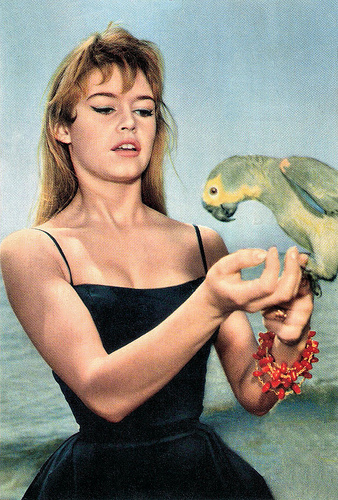
Brigitte Bardot . Dutch postcard by Gebr, Spanjersberg N.V. , Rotterdam, no. 1024, Dutch licency holder for UFA. Sent by mail in 1959. Photo: UFA.
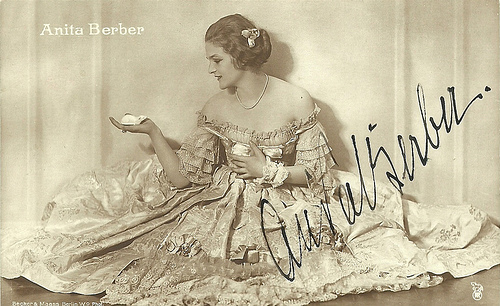
Anita Berber . German postcard by Rotophot in the Film Sterne series. Photo: Becker & Maass. Collection: Didier Hanson.
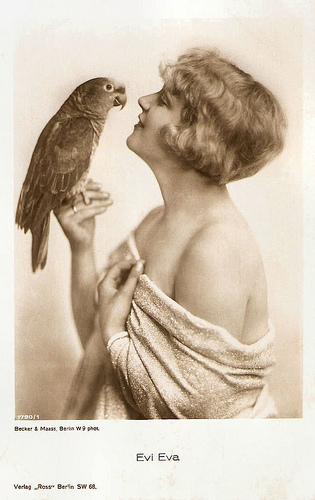
Evi Eva . German postcard by Ross Verlag, no. 1790/1, 1927-1928. Photo: Becker & Maass, Berlin.
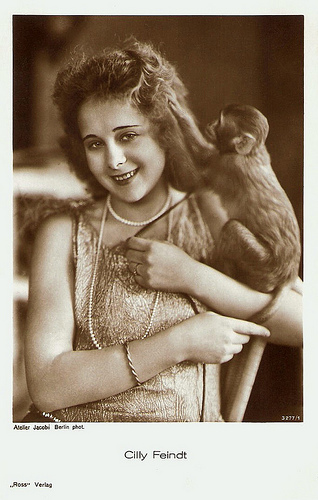
Cilly Feindt . German postcard by Ross Verlag, Berlin, no. 3277/1, 1928-1929. Photo: Atelier Jacobi, Berlin.
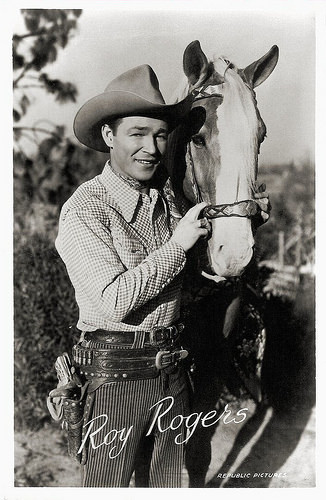
Roy Rogers. Dutch postcard. Photo: Republic Pictures.
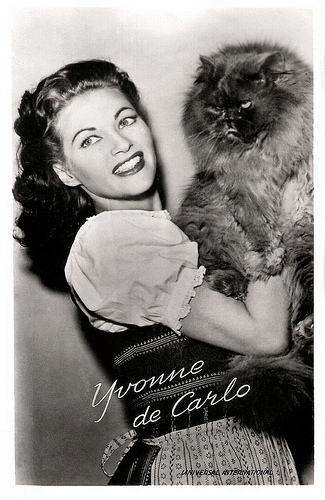
Yvonne De Carlo . Dutch postcard by Takken, no. 3538. Photo: Universal International, 1949.
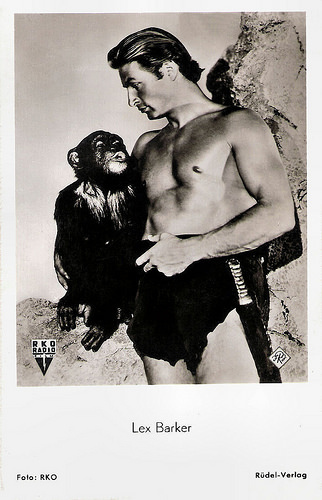
Lex Barker . German postcard by Rüdel-Verlag, Hamburg-Bergedorf, no. 449. Photo: RKO Radio Film.
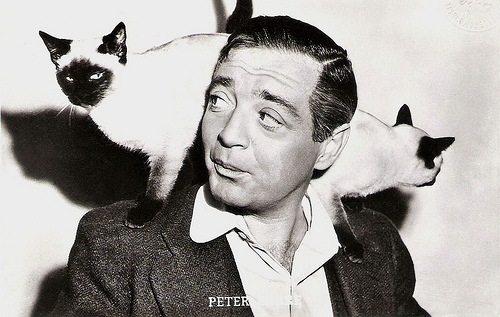
Peter Lorre . Dutch postcard, no. 850. Photo: Warner Bros.
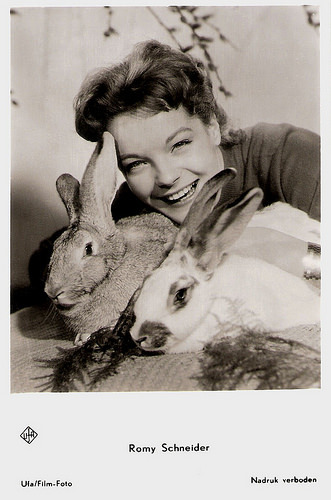
Romy Schneider . Dutch postcard by Gebr. Spanjersberg N.V., Rotterdam, no. 1093. Photo: Ufa.
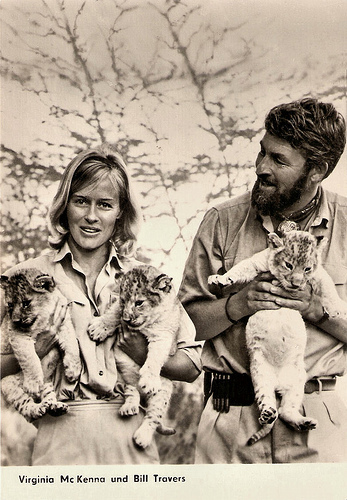
Virginia McKenna and Bill Travers. East-German postcard by VEB Progress Filmvertrieb, Berlin, no. 86/89, 1969.
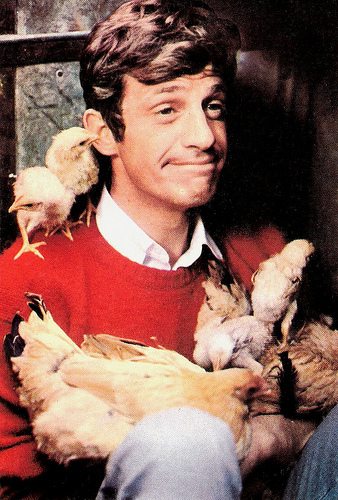
Jean-Paul Belmondo. Italian postcard. Photo: Dear Film. Publicity still for Les tribulations d'un Chinois en Chine/Chinese Adventures in China (Philippe de Broca, 1965).
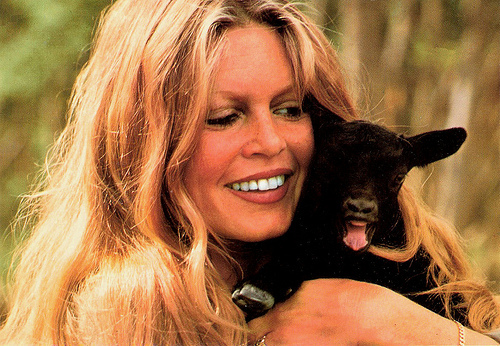
Brigitte Bardot . French postcard by Editions Lyna, Paris, no. 2104. Caption: Tu deviens reponsable pour toujours de ce que tu as apprivoisé. Antoine de St-Exupéry
This is a post for Postcard Friendship Friday, hosted by Beth at the The Best Hearts are Crunchy. You can visit her by clicking on the button below.


Brigitte Bardot . Dutch postcard by Gebr, Spanjersberg N.V. , Rotterdam, no. 1024, Dutch licency holder for UFA. Sent by mail in 1959. Photo: UFA.

Anita Berber . German postcard by Rotophot in the Film Sterne series. Photo: Becker & Maass. Collection: Didier Hanson.

Evi Eva . German postcard by Ross Verlag, no. 1790/1, 1927-1928. Photo: Becker & Maass, Berlin.

Cilly Feindt . German postcard by Ross Verlag, Berlin, no. 3277/1, 1928-1929. Photo: Atelier Jacobi, Berlin.

Roy Rogers. Dutch postcard. Photo: Republic Pictures.

Yvonne De Carlo . Dutch postcard by Takken, no. 3538. Photo: Universal International, 1949.

Lex Barker . German postcard by Rüdel-Verlag, Hamburg-Bergedorf, no. 449. Photo: RKO Radio Film.

Peter Lorre . Dutch postcard, no. 850. Photo: Warner Bros.

Romy Schneider . Dutch postcard by Gebr. Spanjersberg N.V., Rotterdam, no. 1093. Photo: Ufa.

Virginia McKenna and Bill Travers. East-German postcard by VEB Progress Filmvertrieb, Berlin, no. 86/89, 1969.

Jean-Paul Belmondo. Italian postcard. Photo: Dear Film. Publicity still for Les tribulations d'un Chinois en Chine/Chinese Adventures in China (Philippe de Broca, 1965).

Brigitte Bardot . French postcard by Editions Lyna, Paris, no. 2104. Caption: Tu deviens reponsable pour toujours de ce que tu as apprivoisé. Antoine de St-Exupéry
This is a post for Postcard Friendship Friday, hosted by Beth at the The Best Hearts are Crunchy. You can visit her by clicking on the button below.

Published on July 21, 2016 22:00
July 20, 2016
Gaby Sylvia
Gaby Sylvia (1920-1980) had a remarkable career in French cinema of the late 1930s, 1940s and 1950s. She had an even more intense career on the French stage starring in plays by Jean Giraudoux and Jean-Paul Sartre.
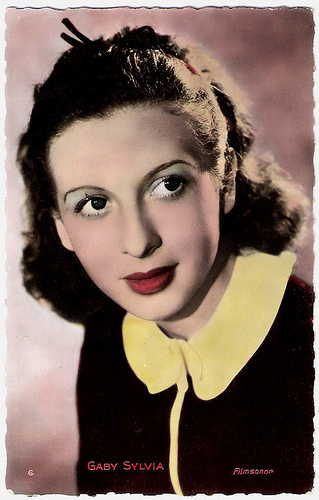
French postcard by Ed. Chantal, Paris, no. 6. Photo: Filmsonor.
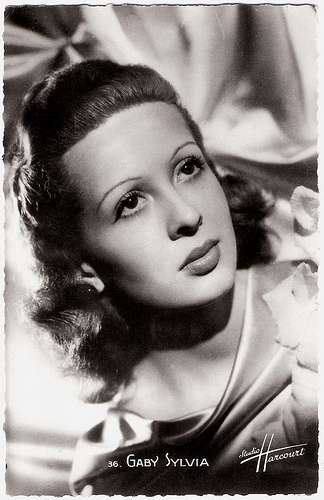
French postcard by S.E.R.P., Paris, no. 36. Photo: Studio Harcourt.
The First French Colour Film
Gaby Sylvia was born Gabriella Zignani in Cesena, Italy, in 1920. She was still a child, when her family moved to France.
While she already played secondary roles in films in the late 1930s and the war years, Gaby Sylvia started to have leading parts in the immediate postwar era.
In 1947 she had the female lead in Capitaine Blomet/ aptain Blomet (Andrée Feix, 1947), staring Fernand Gravey , as well as in the Pierre Loti adaptation Le Marriage de Ramuntcho/The Marriage of Ramuntcho (Max de Vaucorbeil, 1947), considered the first French colour film. The title role was played by André Dassary .
In the late 1940s her most interesting films include the resistance film Mission à Tanger (André Hunebelle, 1949), starring Raymond Rouleau , and the comedy L'Amant de paille/The Straw Lover (Gilles Grangier, 1950), with a debuting Louis de Funès and Jean-Pierre Aumont .
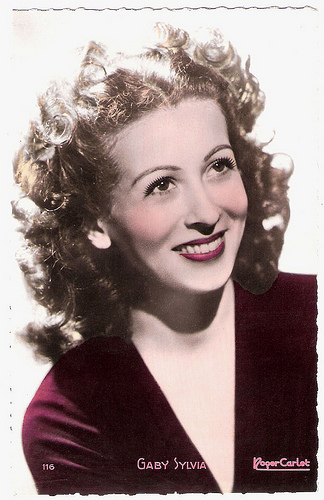
French postcard, no. 116. Photo: Roger-Carlet.
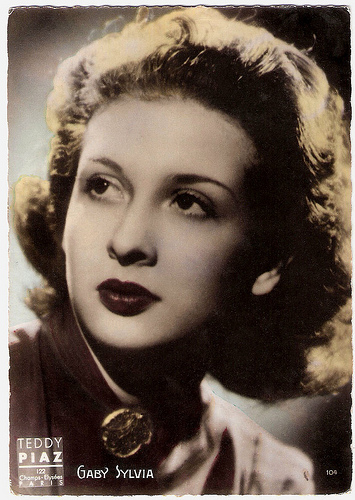
French postcard by Editions O.P., Paris, no. 104. Photo: Teddy Piaz.
Wealthy Baby Killer
Gaby Sylvia played Sylvia, a wealthy baby killer Estelle Rigault opposite Arletty in the Jean-Paul Sartre adaptation Huis clos/No Exit (Jacqueline Audry, 1954). She had also played Estelle in the first stage version of Huis clos, which had its first night on 27 May 1944, at the Théàtre du Vieux-Colombier, and was directed by Raymond Rouleau .
In addition to her role in Sartre's Huis clos, which she repeated on stage in 1961, Sylvia often played in plays by Jean Giraudoux, such as Amphytryon (1956, 1958), and also repeatedly performed in the comedy Piège pour un homme seul (1960, 1962, 1971) by Robert Thomas.
Her reperetory ranged from classics like Molière and Racine to modern writers like Giraudoux, Sarte and Thomas. Between the late 1930s and late 1950s Rouleau directed her in various stage plays.
From the late 1950s on, her stage directors were men like Raymond Gérôme (late 1950s), Jacques Charon (early 1960s), Antoine Bourseiller (mid-1960s), and Andréas Voutsinas (1970s). In 1976 Gaby Sylvia said goodbye to the stage with a performance in Huis clos, directed by Voutsinas.
In 1977 she also played her last film role in the comedy Nous irons tous au paradis/We Will All Meet in Paradise by Yves Robert.
Just turned sixty, Gaby Sylvia died in 1980 in Chamalières (Puy-de-Dôme) in the French Auvergne, because of a brain haemorrhage.
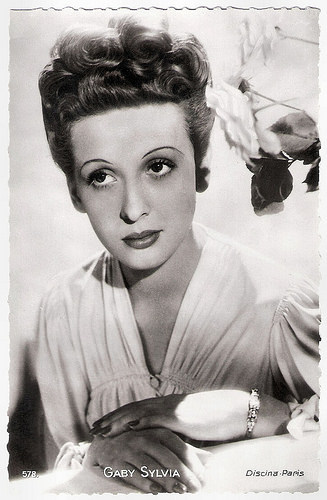
French postcard by Collection Chantal, Paris, no. 578. Photo: Discina, Paris.
Huis Clos/No Exit (1954). Sorry, no subtitles. Source: Classic Movies (YouTube).
Sources: Simon Condès (CinéArtistes - French), Wikipedia (French) and .

French postcard by Ed. Chantal, Paris, no. 6. Photo: Filmsonor.

French postcard by S.E.R.P., Paris, no. 36. Photo: Studio Harcourt.
The First French Colour Film
Gaby Sylvia was born Gabriella Zignani in Cesena, Italy, in 1920. She was still a child, when her family moved to France.
While she already played secondary roles in films in the late 1930s and the war years, Gaby Sylvia started to have leading parts in the immediate postwar era.
In 1947 she had the female lead in Capitaine Blomet/ aptain Blomet (Andrée Feix, 1947), staring Fernand Gravey , as well as in the Pierre Loti adaptation Le Marriage de Ramuntcho/The Marriage of Ramuntcho (Max de Vaucorbeil, 1947), considered the first French colour film. The title role was played by André Dassary .
In the late 1940s her most interesting films include the resistance film Mission à Tanger (André Hunebelle, 1949), starring Raymond Rouleau , and the comedy L'Amant de paille/The Straw Lover (Gilles Grangier, 1950), with a debuting Louis de Funès and Jean-Pierre Aumont .

French postcard, no. 116. Photo: Roger-Carlet.

French postcard by Editions O.P., Paris, no. 104. Photo: Teddy Piaz.
Wealthy Baby Killer
Gaby Sylvia played Sylvia, a wealthy baby killer Estelle Rigault opposite Arletty in the Jean-Paul Sartre adaptation Huis clos/No Exit (Jacqueline Audry, 1954). She had also played Estelle in the first stage version of Huis clos, which had its first night on 27 May 1944, at the Théàtre du Vieux-Colombier, and was directed by Raymond Rouleau .
In addition to her role in Sartre's Huis clos, which she repeated on stage in 1961, Sylvia often played in plays by Jean Giraudoux, such as Amphytryon (1956, 1958), and also repeatedly performed in the comedy Piège pour un homme seul (1960, 1962, 1971) by Robert Thomas.
Her reperetory ranged from classics like Molière and Racine to modern writers like Giraudoux, Sarte and Thomas. Between the late 1930s and late 1950s Rouleau directed her in various stage plays.
From the late 1950s on, her stage directors were men like Raymond Gérôme (late 1950s), Jacques Charon (early 1960s), Antoine Bourseiller (mid-1960s), and Andréas Voutsinas (1970s). In 1976 Gaby Sylvia said goodbye to the stage with a performance in Huis clos, directed by Voutsinas.
In 1977 she also played her last film role in the comedy Nous irons tous au paradis/We Will All Meet in Paradise by Yves Robert.
Just turned sixty, Gaby Sylvia died in 1980 in Chamalières (Puy-de-Dôme) in the French Auvergne, because of a brain haemorrhage.

French postcard by Collection Chantal, Paris, no. 578. Photo: Discina, Paris.
Huis Clos/No Exit (1954). Sorry, no subtitles. Source: Classic Movies (YouTube).
Sources: Simon Condès (CinéArtistes - French), Wikipedia (French) and .
Published on July 20, 2016 22:00
July 19, 2016
Madame DuBarry (1919)
The German silent film Madame DuBarry is an operatic version of the life, loves and death of the legendary 18th-century French courtesan. Pola Negri plays DuBarry, who sleeps her way to the court of King Louis XV, ultimately becoming his mistress. It was one of the spectacular productions which Ernst Lubitsch made in Germany before he became world-famous for his sophisticated sex farces in Hollywood.
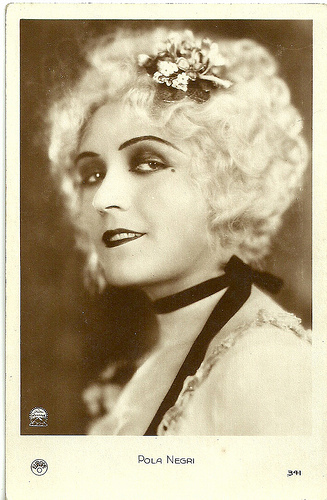
French postcard by Europe, no. 341. Photo: Paramount. Publicity still for the 1928 re-issue of Madame DuBarry (Ernst Lubitsch, 1919) starring Pola Negri.
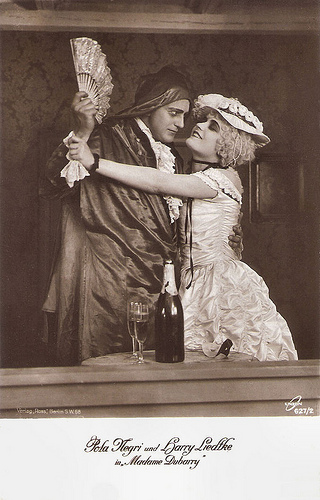
German postcard by Ross Verlag, Berlin, no. 627/2, 1919-1924. Photo: Union. Publicity still for Madame DuBarry (Ernst Lubitsch, 1919) with Pola Negri and Harry Liedtke .
Victim of the Reign of Terror
Ernst Lubitsch 's Madame Dubarry is a historical epic which opened as the premiere attraction of Berlin's impressive Zoopalast theatre on in 1919. Silent film diva Pola Negri plays the milliner’s apprentice Jeanne Marie Vaubernier, who has come to Paris from the country.
In a deal to save her lover Count DuBarry (Karl Platen) from financial ruin, the Parisian milliner's maid alias Madame DuBarry ( Pola Negri ) becomes the influential mistress of the reigning French king, Louis XV ( Emil Jannings ).
However, this relation is much to the dismay of the Minister of State and Finance, Choiseul ( Reinhard Schünzel ). This brilliant schemer had planned for his sister, the Duchesse de Grammont, to become the Queen of France. Choiseul thus starts a campaign to turn the people against the monarch and his new mistress.
Jeanne soon becomes a symbol for the extravagance of the much-hated aristocracy. When the king dies, Jeanne is ousted by the angry masses and she becomes one of the victims of the Reign of Terror during the French Revolution.
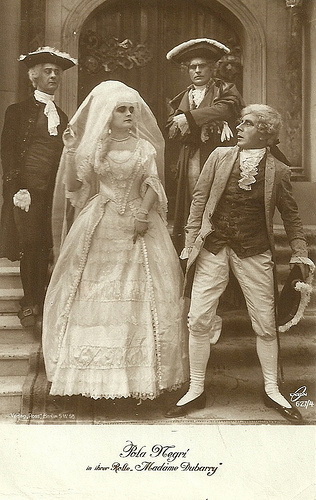
German postcard by Ross Verlag, no. 627/4. Photo: Union Film. Pola Negri in Madame DuBarry (Ernst Lubitsch, 1919). By marrying the aristocrat Guillaume DuBarry (Karl Platen), Jeanne will be accepted at the Royal Court and become Louis XV's mistress. Back right on this card DuBarry's brother Jean (Eduard von Winterstein) who concocted the plan.
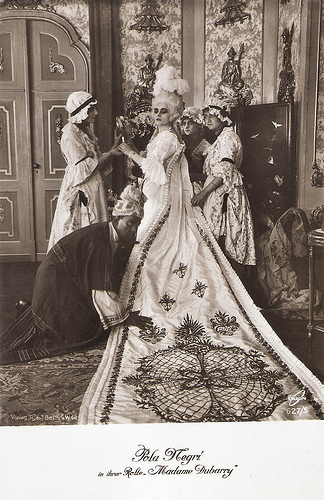
German postcard by Ross Verlag, no. 627/5. Photo: Union Film. Pola Negri in Madame DuBarry (Ernst Lubitsch, 1919).
Far from historical accuracy
Madame DuBarry (1919) had everything: sex, intrigue, war, violence. The film was a success in both Europe (except in France) and the U.S., where it was released as Passion, and successfully re-issued in 1928. It was one of the greatest triumphs of Pola Negri .
Negri's flirtatious Madame DuBarry is both comical and sympathetic. Emil Jannings is also excellent as a lecherous, bombastic King Louis XV. Harry Liedtke plays Jeanne's first love, the student Armand de Foix.
Madame DuBarry (1919) was directed by Ernst Lubitsch , written by Norbert Falk and Hanns Kräly. It strays far from historical accuracy, but the narrative is at least coherent.
In reality, King Louis XV died 15 years before the beginning of the French Revolution and Madame DuBarry was long gone from Versailles by the time of the storming of the Bastille. She was 50 when she was executed during the Reign of Terror.
Despite these flaws, Chuck Reilly reviews at IMDb , "the gigantic mob scenes and the final shots of poor Pola being carted off to the guillotine are well-staged and resonate even with modern viewers".
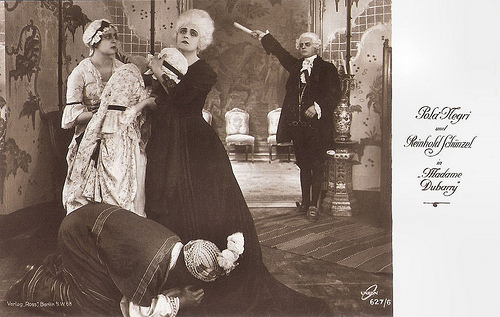
German postcard by Ross Verlag, no. 627/6. Photo: Union Film. Publicity still of Reinhold Schünzel and Pola Negri in Madame DuBarry (Ernst Lubitsch, 1919). After the death of king Louis XV ( Emil Jannings ), his minister Choiseul (Schünzel) chases DuBarry (Negri) from the Royal palace.
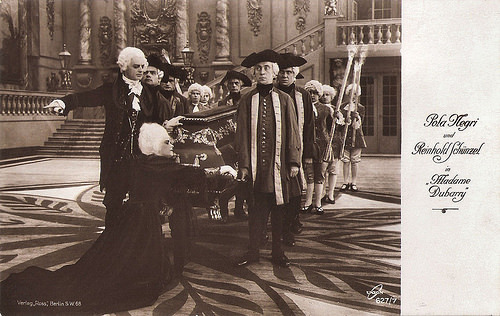
German postcard by Ross Verlag, Berlin, no. 627/7. Photo: Union Film. Publicity still of Reinhold Schünzel and Pola Negri in Madame DuBarry (Ernst Lubitsch, 1919).
Sources: Hal Erickson (AllMovie), Chuck Reilly (IMDb), Filmportal.de, Wikipedia and IMDb.

French postcard by Europe, no. 341. Photo: Paramount. Publicity still for the 1928 re-issue of Madame DuBarry (Ernst Lubitsch, 1919) starring Pola Negri.

German postcard by Ross Verlag, Berlin, no. 627/2, 1919-1924. Photo: Union. Publicity still for Madame DuBarry (Ernst Lubitsch, 1919) with Pola Negri and Harry Liedtke .
Victim of the Reign of Terror
Ernst Lubitsch 's Madame Dubarry is a historical epic which opened as the premiere attraction of Berlin's impressive Zoopalast theatre on in 1919. Silent film diva Pola Negri plays the milliner’s apprentice Jeanne Marie Vaubernier, who has come to Paris from the country.
In a deal to save her lover Count DuBarry (Karl Platen) from financial ruin, the Parisian milliner's maid alias Madame DuBarry ( Pola Negri ) becomes the influential mistress of the reigning French king, Louis XV ( Emil Jannings ).
However, this relation is much to the dismay of the Minister of State and Finance, Choiseul ( Reinhard Schünzel ). This brilliant schemer had planned for his sister, the Duchesse de Grammont, to become the Queen of France. Choiseul thus starts a campaign to turn the people against the monarch and his new mistress.
Jeanne soon becomes a symbol for the extravagance of the much-hated aristocracy. When the king dies, Jeanne is ousted by the angry masses and she becomes one of the victims of the Reign of Terror during the French Revolution.

German postcard by Ross Verlag, no. 627/4. Photo: Union Film. Pola Negri in Madame DuBarry (Ernst Lubitsch, 1919). By marrying the aristocrat Guillaume DuBarry (Karl Platen), Jeanne will be accepted at the Royal Court and become Louis XV's mistress. Back right on this card DuBarry's brother Jean (Eduard von Winterstein) who concocted the plan.

German postcard by Ross Verlag, no. 627/5. Photo: Union Film. Pola Negri in Madame DuBarry (Ernst Lubitsch, 1919).
Far from historical accuracy
Madame DuBarry (1919) had everything: sex, intrigue, war, violence. The film was a success in both Europe (except in France) and the U.S., where it was released as Passion, and successfully re-issued in 1928. It was one of the greatest triumphs of Pola Negri .
Negri's flirtatious Madame DuBarry is both comical and sympathetic. Emil Jannings is also excellent as a lecherous, bombastic King Louis XV. Harry Liedtke plays Jeanne's first love, the student Armand de Foix.
Madame DuBarry (1919) was directed by Ernst Lubitsch , written by Norbert Falk and Hanns Kräly. It strays far from historical accuracy, but the narrative is at least coherent.
In reality, King Louis XV died 15 years before the beginning of the French Revolution and Madame DuBarry was long gone from Versailles by the time of the storming of the Bastille. She was 50 when she was executed during the Reign of Terror.
Despite these flaws, Chuck Reilly reviews at IMDb , "the gigantic mob scenes and the final shots of poor Pola being carted off to the guillotine are well-staged and resonate even with modern viewers".

German postcard by Ross Verlag, no. 627/6. Photo: Union Film. Publicity still of Reinhold Schünzel and Pola Negri in Madame DuBarry (Ernst Lubitsch, 1919). After the death of king Louis XV ( Emil Jannings ), his minister Choiseul (Schünzel) chases DuBarry (Negri) from the Royal palace.

German postcard by Ross Verlag, Berlin, no. 627/7. Photo: Union Film. Publicity still of Reinhold Schünzel and Pola Negri in Madame DuBarry (Ernst Lubitsch, 1919).
Sources: Hal Erickson (AllMovie), Chuck Reilly (IMDb), Filmportal.de, Wikipedia and IMDb.
Published on July 19, 2016 22:00
July 18, 2016
Berthe Bovy
Belgian stage and screen actress Berthe Bovy (1887-1977) was a regular performer at the Comédie Française since 1907. She also acted in some 30 early silent films, mainly for Pathé, and in some 20 sound films between the 1930s and early 1970s. Bovy also worked for TV.
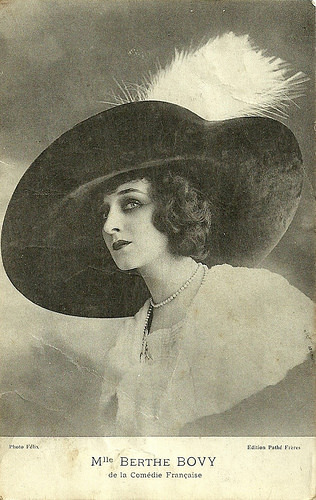
French postcard by Edition Pathé Frères. Photo: Félix. Caption: Mlle Berthe Bovy of the Comédie Française.
Her Idol Sarah Bernhardt
Berthe Bovy, sometimes known as Betty Bovy, was born in 1887 in Cheratte, now part of the commune of Visé, in the province of Liège. Berthe was the daughter of Théophile Bovy, journalist, poet and playwright and best known as writer of the official anthem of Wallonia, Le chant des Wallons.
He made sure that his daughter was playing small roles already at the age of six in the Liège theaters. When she was thirteen, her father arranged by his friend, the composer Reynaldo Hahn, a personal encounter with her idol Sarah Bernhardt . After this meeting, Bovy decided to enroll at the Royal Conservatory in Brussels, where she was in the class of Jeanne Tordeur, a former actress of the Comédie-Française. From 1904 to 1906 she studied further at the Paris Conservatory where she attended the class of Charles Le Bargy.
After a few minor roles played at the Théâtre de la Gaîté and Théâtre de la Porte Saint-Martin, she starred alongside Sarah Bernhardt in the play L'Aiglon (The Eaglet) by Edmond Rostand. In 1907 she joined the Comédie-Française and she debuted there with a small role in the play Monsieur Alphonse by Alexandre Dumas fils. A first leading role she got in Le Baiser (The Kiss), an opéra comique by Adolphe Deslandres in which she took a transvestite role.
Her breakthrough as an actress came shortly thereafter in La Cousine Bette by Honoré de Balzac. In 1920 she became an effective member of the Comédie-Française. The following year she garnered much success with the play La Terre during her tour. At the Comédie-Française, she created roles in several plays by e.g. Maurice Maeterlinck, Tristan Bernard and Luigi Pirandello. Among her pupils were Madeleine Renaud , Fernand Ledoux, and her third husband, Pierre Fresnay .
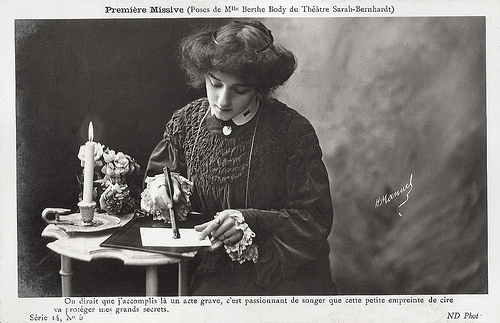
French postcard by ND Phot., serie 14, no. 5. Photo: H. Manuel. Première Missive: Poses by Mlle Berthe Bovy [misspelled as Body] from the Theatre Sarah Bernhardt. Caption: One would say I just accomplished a grave action, while it is exciting to think that this small wax print will protect my biggest secrets.
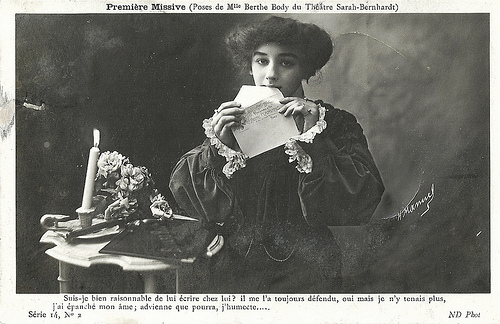
French postcard by ND Phot., serie 14, no. 2. Photo: H. Manuel. Première Missive: Poses by Mlle Berthe Bovy [misspelled as Body] from the Theatre Sarah Bernhardt. Caption: Am I reasonable to write him at his place? He always forbid me so, yes, but I could not stand it any more, I poured out my soul; whatever may came of it, I moisten this...
Like a Stradivarius violin
In 1930 Berthe Bovy was very successful with the drama La Voix humaine (The Human Voice) which Jean Cocteau had written for her and in which she took on the role of a woman talking on the phone for the last time with her lover who has just dumped her to marry another.
Cocteau was smitten with her and said she vibrated like a Stradivarius violin. The one-act play was registered on two 78" records the same year by Columbia. In 1957, Bovy would do a second recording for Pathé.
In 1942, during World War II, Berthe Bovy refused to participate in a tour through Germany. Therefore she had to leave the Comédie-Française. Bovy then acted in boulevard theatre pieces such as Arsenic and Old Lace by Joseph Kesselring and created for the first time the role of an older dignified, spirited lady.
In 1946 she was reinstated in her honour and after she was admitted to a honorary membership, she went back to work at the Comédie-Française in 1950. Until 1963, she played roles in plays by e.g. André Gide.
Her last role at the famed theatre house was in Mary Stuart by Friedrich von Schiller in 1963. In 1967 at the age of eighty, with the role of Madame Pernelle in the play Tartuffe by Molière, she took farewell to the stage.
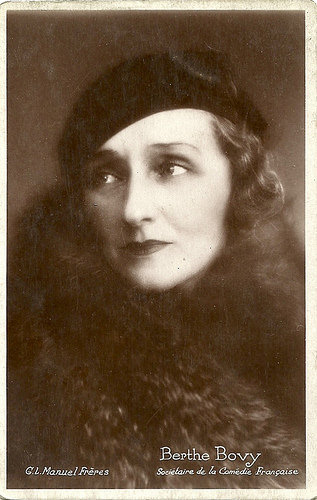
French postcard. Photo: G.L. Manuel Frères. Caption: Berthe Bovy, Sociétaire de la Comédie Française.
Film d'Art
How major was Berthe Bovy's film career? While Wikipedia claims that Bovy played roles in a hundred silent films, IMDb only mentions some thirty titles.
In 1908 she debuted on the screen as a page in L'Assassinat du Duc de Guise, the first Film d’Art film, which brought prestige to the new medium of cinema, and attracted stage actors such as Charles Le Bargy , Gabrielle Robinne and Albert Lambert.
After that she became a regular actress at Pathé Frères in mostly historical dramas. Her first lead role was Queen Margaret of Valois in La reine Margot/Queen Margot (Camille de Morlhon, 1910). While De Morlhon, André Calmettes and Albert Capellani directed her in historical films, she also acted in modern dramas by Gerard Bourgeois and others.
Her main co-actors in her Pathé years were René Alexandre , Louis Ravet and Gabrielle Robinne . Until early 1914 Bovy had a steady output at Pathé of 8 to 10 films per year, but then quitted the silent screen and only returned in 1921 for the part of La Trouille in the film adaptation of La Terre by André Antoine, who just before had toured with the theatrical adaptation.
After a long absence, Bovy returned to the screen when sound film had been well established. Between 1938 and 1971 she played in twenty sound films and worked with directors such as Julien Duvivier and Christian-Jaque.
She was notable as Mme Bonnet in Boule de suif (Christian-Jacque, 1945). In L'Armoire volante (Carlo Rim, 1948), Bovy played alongside Fernandel, while in Rim’s La Maison Bonnadieu (Carlo Rim, 1951) she acted opposite Bernard Blier , Danielle Darrieux and Françoise Arnoul .
Other memorable titles were Le Joueur (Gerhard Lamprecht, Louis Daquin, 1938), and Fantômas contre Fantômas (Robert Vernay, 1948). In the 1960s, Bovy also played several roles in plays and serials on television.
Berthe Bovy was married and divorced three times, first to Charles Gribouval, secretary of the Comédie-Française, secondly with artist Ion Anton Ion-Don, and thirdly, in 1929, with Pierre Jules Louis Laudenbach, better known by his stage name Pierre Fresnay .
Berthe Bovy died in 1977 at Montgeron in France and she is buried in Liège, Belgium.
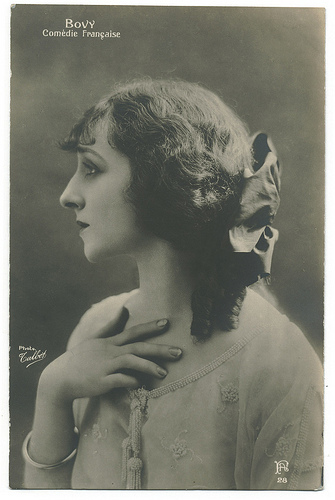
French postcard by FA, no. 28. Photo: Talbot. Collection: Manuel Palomino Arjona (Flickr).
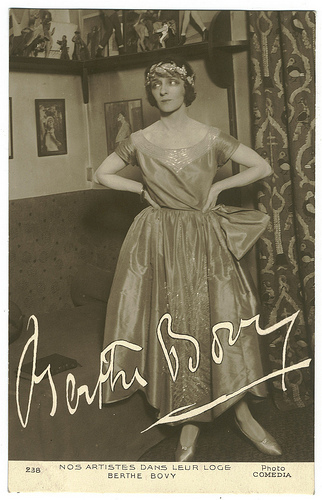
French postcard by Comoedia in the Nos Artistes dans leur Loge series, no. 238. Photo: Comoedia. Collection: Manuel Palomino Arjona (Flickr).
Sources: Cine-Ressources, Wikipedia (French, Dutch and English), and

French postcard by Edition Pathé Frères. Photo: Félix. Caption: Mlle Berthe Bovy of the Comédie Française.
Her Idol Sarah Bernhardt
Berthe Bovy, sometimes known as Betty Bovy, was born in 1887 in Cheratte, now part of the commune of Visé, in the province of Liège. Berthe was the daughter of Théophile Bovy, journalist, poet and playwright and best known as writer of the official anthem of Wallonia, Le chant des Wallons.
He made sure that his daughter was playing small roles already at the age of six in the Liège theaters. When she was thirteen, her father arranged by his friend, the composer Reynaldo Hahn, a personal encounter with her idol Sarah Bernhardt . After this meeting, Bovy decided to enroll at the Royal Conservatory in Brussels, where she was in the class of Jeanne Tordeur, a former actress of the Comédie-Française. From 1904 to 1906 she studied further at the Paris Conservatory where she attended the class of Charles Le Bargy.
After a few minor roles played at the Théâtre de la Gaîté and Théâtre de la Porte Saint-Martin, she starred alongside Sarah Bernhardt in the play L'Aiglon (The Eaglet) by Edmond Rostand. In 1907 she joined the Comédie-Française and she debuted there with a small role in the play Monsieur Alphonse by Alexandre Dumas fils. A first leading role she got in Le Baiser (The Kiss), an opéra comique by Adolphe Deslandres in which she took a transvestite role.
Her breakthrough as an actress came shortly thereafter in La Cousine Bette by Honoré de Balzac. In 1920 she became an effective member of the Comédie-Française. The following year she garnered much success with the play La Terre during her tour. At the Comédie-Française, she created roles in several plays by e.g. Maurice Maeterlinck, Tristan Bernard and Luigi Pirandello. Among her pupils were Madeleine Renaud , Fernand Ledoux, and her third husband, Pierre Fresnay .

French postcard by ND Phot., serie 14, no. 5. Photo: H. Manuel. Première Missive: Poses by Mlle Berthe Bovy [misspelled as Body] from the Theatre Sarah Bernhardt. Caption: One would say I just accomplished a grave action, while it is exciting to think that this small wax print will protect my biggest secrets.

French postcard by ND Phot., serie 14, no. 2. Photo: H. Manuel. Première Missive: Poses by Mlle Berthe Bovy [misspelled as Body] from the Theatre Sarah Bernhardt. Caption: Am I reasonable to write him at his place? He always forbid me so, yes, but I could not stand it any more, I poured out my soul; whatever may came of it, I moisten this...
Like a Stradivarius violin
In 1930 Berthe Bovy was very successful with the drama La Voix humaine (The Human Voice) which Jean Cocteau had written for her and in which she took on the role of a woman talking on the phone for the last time with her lover who has just dumped her to marry another.
Cocteau was smitten with her and said she vibrated like a Stradivarius violin. The one-act play was registered on two 78" records the same year by Columbia. In 1957, Bovy would do a second recording for Pathé.
In 1942, during World War II, Berthe Bovy refused to participate in a tour through Germany. Therefore she had to leave the Comédie-Française. Bovy then acted in boulevard theatre pieces such as Arsenic and Old Lace by Joseph Kesselring and created for the first time the role of an older dignified, spirited lady.
In 1946 she was reinstated in her honour and after she was admitted to a honorary membership, she went back to work at the Comédie-Française in 1950. Until 1963, she played roles in plays by e.g. André Gide.
Her last role at the famed theatre house was in Mary Stuart by Friedrich von Schiller in 1963. In 1967 at the age of eighty, with the role of Madame Pernelle in the play Tartuffe by Molière, she took farewell to the stage.

French postcard. Photo: G.L. Manuel Frères. Caption: Berthe Bovy, Sociétaire de la Comédie Française.
Film d'Art
How major was Berthe Bovy's film career? While Wikipedia claims that Bovy played roles in a hundred silent films, IMDb only mentions some thirty titles.
In 1908 she debuted on the screen as a page in L'Assassinat du Duc de Guise, the first Film d’Art film, which brought prestige to the new medium of cinema, and attracted stage actors such as Charles Le Bargy , Gabrielle Robinne and Albert Lambert.
After that she became a regular actress at Pathé Frères in mostly historical dramas. Her first lead role was Queen Margaret of Valois in La reine Margot/Queen Margot (Camille de Morlhon, 1910). While De Morlhon, André Calmettes and Albert Capellani directed her in historical films, she also acted in modern dramas by Gerard Bourgeois and others.
Her main co-actors in her Pathé years were René Alexandre , Louis Ravet and Gabrielle Robinne . Until early 1914 Bovy had a steady output at Pathé of 8 to 10 films per year, but then quitted the silent screen and only returned in 1921 for the part of La Trouille in the film adaptation of La Terre by André Antoine, who just before had toured with the theatrical adaptation.
After a long absence, Bovy returned to the screen when sound film had been well established. Between 1938 and 1971 she played in twenty sound films and worked with directors such as Julien Duvivier and Christian-Jaque.
She was notable as Mme Bonnet in Boule de suif (Christian-Jacque, 1945). In L'Armoire volante (Carlo Rim, 1948), Bovy played alongside Fernandel, while in Rim’s La Maison Bonnadieu (Carlo Rim, 1951) she acted opposite Bernard Blier , Danielle Darrieux and Françoise Arnoul .
Other memorable titles were Le Joueur (Gerhard Lamprecht, Louis Daquin, 1938), and Fantômas contre Fantômas (Robert Vernay, 1948). In the 1960s, Bovy also played several roles in plays and serials on television.
Berthe Bovy was married and divorced three times, first to Charles Gribouval, secretary of the Comédie-Française, secondly with artist Ion Anton Ion-Don, and thirdly, in 1929, with Pierre Jules Louis Laudenbach, better known by his stage name Pierre Fresnay .
Berthe Bovy died in 1977 at Montgeron in France and she is buried in Liège, Belgium.

French postcard by FA, no. 28. Photo: Talbot. Collection: Manuel Palomino Arjona (Flickr).

French postcard by Comoedia in the Nos Artistes dans leur Loge series, no. 238. Photo: Comoedia. Collection: Manuel Palomino Arjona (Flickr).
Sources: Cine-Ressources, Wikipedia (French, Dutch and English), and
Published on July 18, 2016 22:00
July 17, 2016
Dina Sassoli
Beautiful Dina Sassoli (1920-2008) was an Italian stage and screen actress, who broke through with the historical drama I promessi sposi/The Betrothed (Mario Camerini, 1941).
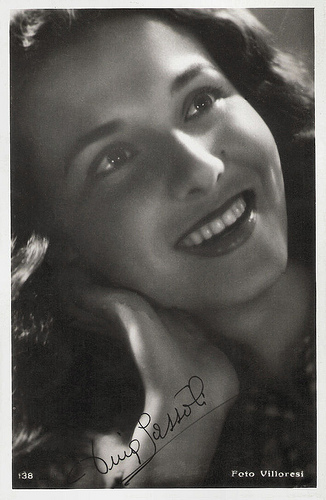
Italian postcard by Stab. Angell, Terni / A. Terzeli, Roma, no. 138. Photo: Foto Villoresi.
Success with a Twist
Dina Sassoli was born in Rimini, Italy in 1920. In 1941, she suddenly became famous internationally by her performance as Lucia in the historical drama film I promessi sposi/The Betrothed aka The Spirit and the Flesh (1941) by Mario Camerini.
I promessi sposi is an adaptation of the famous 1827 novel The Betrothed by Alessandro Manzoni. The film's producers organised a competition to select the lead actress, which was eventually won by Sassoli. The competition was modelled on the hunt for Scarlett O'Hara by the American producer David O. Selznick for Gone With the Wind.
Sassoli's success came with a twist. She had married a young journalist, who was considered antifascist by the government. In 1942, he disappeared. Devastated, Sassoli almost gave up her career.
However, in the war years she played several leads in films. An example is Nessuno torna indietro/None came back (Alessandro Blasetti, 1943, released 1945), adapted from the novel of Alba de Cespedes.
In this film on seven college girls she plays Milly, a shy and romantic girl who loves music. She falls in love with a blind man, but then suddenly dies. Her co-stars were Valentina Cortese , Maria Mercader , Doris Duranti , Elisa Cegani, Mariella Lotti and Maria Denis .
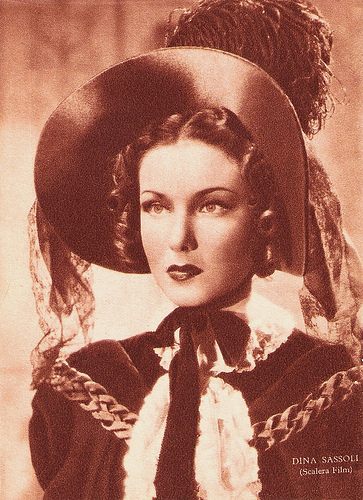
Italian postcard by Rizzoli, Milano, 1942-XX. Photo: Scalera Film. Publicity still for Don Giovanni/Loves of Don Juan (Dino Falconi, 1942).
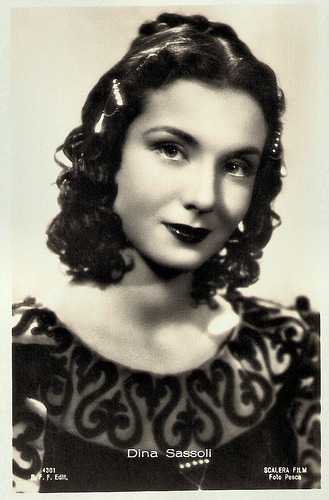
Italian postcard by B.F.F. Edit. (Ballerini & Fratini), Firenze, no. 4301. Photo: Scalera Film / Foto Pesce. Publicity still for Don Giovanni/Loves of Don Juan (Dino Falconi, 1942).
Tormented Love Affair
Dina Sassoli also starred in memorable films from the postwar era such as Un giorno nella vita/A day in the life (Alessandro Blasetti, 1946), Umanità/Humanity (Jack Salvatori, 1946), and Il mulino del Po/The Mill on the Po (Alberto Lattuada, 1948), in which she plays the sister of Jacques Sernas .
In the war drama Un giorno nella vita, Sassoli was one of the nuns who take care of a group of partisans, after which German revenge follows. In the little known production Umanità, she is a young refugee who sincerely suffered the war and has an affair with a refugee camp doctor, until her fiancé shows up and the doctor goes back to his wife. The film was shot in the makeshift refugee camp in Cinecittà.
However, Sassoli discovered the stage in the postwar era as well, acting with Vittorio Gassman in Kean and with Gino Cervi in Cyrano de Bergerac, and also with Anna Proclemer and Gabriele Lavia.
Until the mid-1980s – and with an intermission between the mid-1950s and 1970 - Sassoli would act in mostly smaller parts in about fifty films made by directors such as Guido Brignone, Corrado d’Errico, Mario Mattioli, Camillo Mastrocinque, Larry Peerce, Giuliano Montaldo, Giuseppe Bertolucci and Luigi Comencini.
Her last film parts were in Voltati Eugenio/Eugenio (Luigi Comencini, 1980) with Francesco Bonelli, Oggetti smarriti/An Italian Woman (Giuseppe Bertolucci, 1980) with Bruno Ganz, and in La storia/History (Luigi Comencini, 1985) starring Claudia Cardinale .
Of Sassoli's TV performances the one best remembered is her interpretation in the television drama Sorelle Materassi (1972) directed by Mario Ferrero.
Famous was Dina Sassoli's tormented love affair with Massimo Serato who ultimately left her for Anna Magnani . Dina Sassoli died in Rome in 2008.
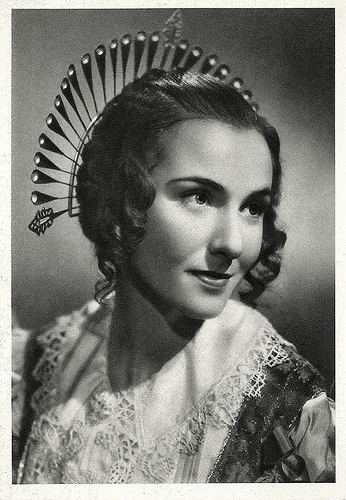
Italian postcard by S.A. Grafitalia, Milano (Milan), no. 10. Photo: Film Lux. Publicity still for I Promessi Sposi/The Spirit and the Flesh (Mario Camerini, 1941) with Dina Sassoli as Lucia Mondella.
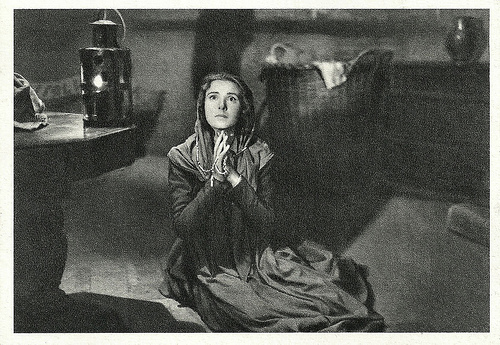
Italian postcard by S.A. Grafitalia, Milano (Milan), no. 10. Photo: Film Lux. Publicity still for I Promessi Sposi/The Spirit and the Flesh (Mario Camerini, 1941) with Dina Sassoli as Lucia Mondella.
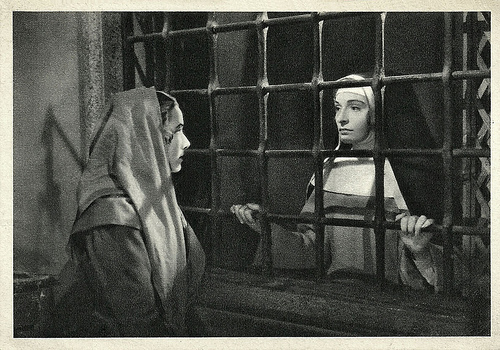
Italian postcard by S.A. Grafitalia, Milano (Milan), no. 10. Photo: Film Lux. Publicity still for I Promessi Sposi/The Spirit and the Flesh (Mario Camerini, 1941) with Dina Sassoli as Lucia Mondella and Eva Maltagliati as the Nun of Monza.
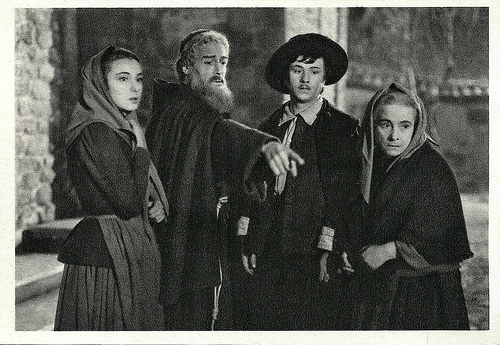
Italian postcard by S.A. Grafitalia, Milano (Milan), no. 10. Photo: Film Lux. Publicity still for I Promessi Sposi/The Spirit and the Flesh (Mario Camerini, 1941) with Dina Sassoli (Lucia), Luis Hurtado (Fra' Cristoforo), Gino Cervi (Renzo), and Gilda Marchiò (Agnese, Lucia's mother).
Sources: Christophe Lawniczak (Ciné-Artistes - French), Wikipedia (Italian and English) and .

Italian postcard by Stab. Angell, Terni / A. Terzeli, Roma, no. 138. Photo: Foto Villoresi.
Success with a Twist
Dina Sassoli was born in Rimini, Italy in 1920. In 1941, she suddenly became famous internationally by her performance as Lucia in the historical drama film I promessi sposi/The Betrothed aka The Spirit and the Flesh (1941) by Mario Camerini.
I promessi sposi is an adaptation of the famous 1827 novel The Betrothed by Alessandro Manzoni. The film's producers organised a competition to select the lead actress, which was eventually won by Sassoli. The competition was modelled on the hunt for Scarlett O'Hara by the American producer David O. Selznick for Gone With the Wind.
Sassoli's success came with a twist. She had married a young journalist, who was considered antifascist by the government. In 1942, he disappeared. Devastated, Sassoli almost gave up her career.
However, in the war years she played several leads in films. An example is Nessuno torna indietro/None came back (Alessandro Blasetti, 1943, released 1945), adapted from the novel of Alba de Cespedes.
In this film on seven college girls she plays Milly, a shy and romantic girl who loves music. She falls in love with a blind man, but then suddenly dies. Her co-stars were Valentina Cortese , Maria Mercader , Doris Duranti , Elisa Cegani, Mariella Lotti and Maria Denis .

Italian postcard by Rizzoli, Milano, 1942-XX. Photo: Scalera Film. Publicity still for Don Giovanni/Loves of Don Juan (Dino Falconi, 1942).

Italian postcard by B.F.F. Edit. (Ballerini & Fratini), Firenze, no. 4301. Photo: Scalera Film / Foto Pesce. Publicity still for Don Giovanni/Loves of Don Juan (Dino Falconi, 1942).
Tormented Love Affair
Dina Sassoli also starred in memorable films from the postwar era such as Un giorno nella vita/A day in the life (Alessandro Blasetti, 1946), Umanità/Humanity (Jack Salvatori, 1946), and Il mulino del Po/The Mill on the Po (Alberto Lattuada, 1948), in which she plays the sister of Jacques Sernas .
In the war drama Un giorno nella vita, Sassoli was one of the nuns who take care of a group of partisans, after which German revenge follows. In the little known production Umanità, she is a young refugee who sincerely suffered the war and has an affair with a refugee camp doctor, until her fiancé shows up and the doctor goes back to his wife. The film was shot in the makeshift refugee camp in Cinecittà.
However, Sassoli discovered the stage in the postwar era as well, acting with Vittorio Gassman in Kean and with Gino Cervi in Cyrano de Bergerac, and also with Anna Proclemer and Gabriele Lavia.
Until the mid-1980s – and with an intermission between the mid-1950s and 1970 - Sassoli would act in mostly smaller parts in about fifty films made by directors such as Guido Brignone, Corrado d’Errico, Mario Mattioli, Camillo Mastrocinque, Larry Peerce, Giuliano Montaldo, Giuseppe Bertolucci and Luigi Comencini.
Her last film parts were in Voltati Eugenio/Eugenio (Luigi Comencini, 1980) with Francesco Bonelli, Oggetti smarriti/An Italian Woman (Giuseppe Bertolucci, 1980) with Bruno Ganz, and in La storia/History (Luigi Comencini, 1985) starring Claudia Cardinale .
Of Sassoli's TV performances the one best remembered is her interpretation in the television drama Sorelle Materassi (1972) directed by Mario Ferrero.
Famous was Dina Sassoli's tormented love affair with Massimo Serato who ultimately left her for Anna Magnani . Dina Sassoli died in Rome in 2008.

Italian postcard by S.A. Grafitalia, Milano (Milan), no. 10. Photo: Film Lux. Publicity still for I Promessi Sposi/The Spirit and the Flesh (Mario Camerini, 1941) with Dina Sassoli as Lucia Mondella.

Italian postcard by S.A. Grafitalia, Milano (Milan), no. 10. Photo: Film Lux. Publicity still for I Promessi Sposi/The Spirit and the Flesh (Mario Camerini, 1941) with Dina Sassoli as Lucia Mondella.

Italian postcard by S.A. Grafitalia, Milano (Milan), no. 10. Photo: Film Lux. Publicity still for I Promessi Sposi/The Spirit and the Flesh (Mario Camerini, 1941) with Dina Sassoli as Lucia Mondella and Eva Maltagliati as the Nun of Monza.

Italian postcard by S.A. Grafitalia, Milano (Milan), no. 10. Photo: Film Lux. Publicity still for I Promessi Sposi/The Spirit and the Flesh (Mario Camerini, 1941) with Dina Sassoli (Lucia), Luis Hurtado (Fra' Cristoforo), Gino Cervi (Renzo), and Gilda Marchiò (Agnese, Lucia's mother).
Sources: Christophe Lawniczak (Ciné-Artistes - French), Wikipedia (Italian and English) and .
Published on July 17, 2016 22:00
July 16, 2016
Elmire Vautier
French actress Elmire Vautier (1897-1954) had a career in cinema between the late 1910s and the early 1940s.
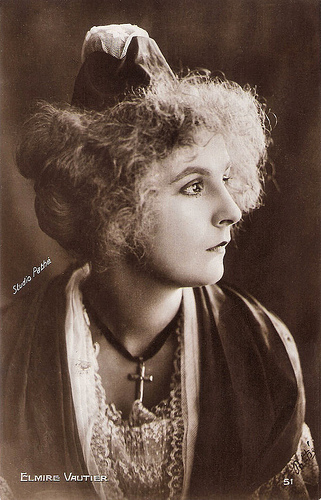
French postcard by Editions Cinémagazine, no. 51. Photo: Studio Pathé.
An Illegitimate Child
Armandine Elmire Vautier was born in Grandchain, Eure, France in 1897.
She made her film debut in Sa gosse/Her Kid (1919), directed by Henri Desfontaines. It was the story about a woman from the countryside who moves to Paris after having an illegitimate child, but she does not like the capital and longs for her daughter.
From then on Vautier had a prolific career in French silent cinema, often paired with René Navarre , but also with Renée Sylvaire .
Memorable titles are Le roi de Camargue/The King of the Camargue (André Hugon, 1922), Judith (Georges Monca, Rose Pansini, 1922), the serial L'homme aux trois masques/The Man with Three Masks (Émile Keppens, René Navarre, 1922) with Gina Manès , Vidoq (Jean Kemm, 1923), Ferragus (Gaston Ravel, 1923) with British actor Stewart Rome , Jean Chouan (Luitz-Morat, 1925), Belphégor (Henri Desfontaines, 1927), and La tentation/Temptation (René Barberis, René Leprince, 1929).
In Le roi de Camargue Vautier, she plays Lisette, a girl who is in love with Renaud ( Charles de Rochefort ), the 'king' of the Camargue. When he falls for a dashing gypsy woman, she tries to drown herself.
In Judith she is a countess whose husband is suspected of murder, and in Vidoq she is Manon la blonde, wife of Vidoq ( René Navarre ) but now the mistress of a rich man.
In Ferragus she is the daughter of an ex-convict (Navarre), now leader of a powerful secret society. A young man (Lucien Dalsace) is interested in her, but her father fears the unmasking of the family reputation.
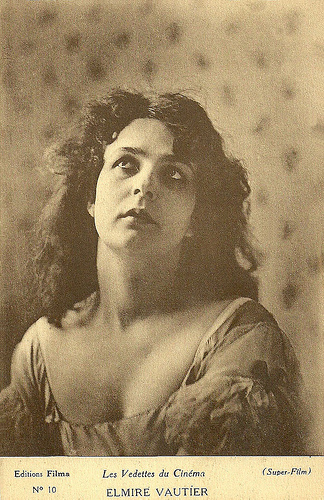
French postcard by Editions Filma in the series Les Vedettes du Cinéma, no. 10. Photo: Super-Film.
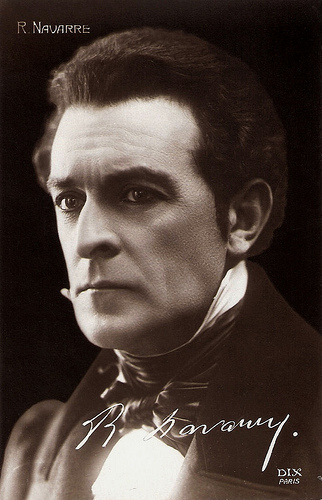
René Navarre. French postcard. Photo: DIX, Paris.
Dressed As A Ghost
One of Elmire Vautier's leading roles in the 1920s was that of Simone Desroches, who haunts the Louvre dressed as the ghost Belphégor, trying to steal from the museum. Eventually she is unmasked by the detective Chantecoq ( René Navarre ) and her own friend, the journalist Jacques Bellegarde (Lucien Dalsace).
In 1930 Vautier made the passage to sound film, playing in French productions shot at the Parisian Paramount studios. From 1931 and 1934 she was away from the screen for a while, and when she returned her parts had become smaller.
In the late 1930s and early 1940s she still acted in a few period pieces like Le patriote/The Mad Emperor (Maurice Tourneur, 1938) with Harry Baur , and Mam'zelle Bonaparte/Miss Bonaparte (Maurice Tourneur, 1942) starring Edwige Feuillère , but then her film career was over.
Elmire Vautier died in Livilliers, Val d'Oise, France in 1954. She was 56. For a time, she was married to René Navarre , but no exact dates are available.
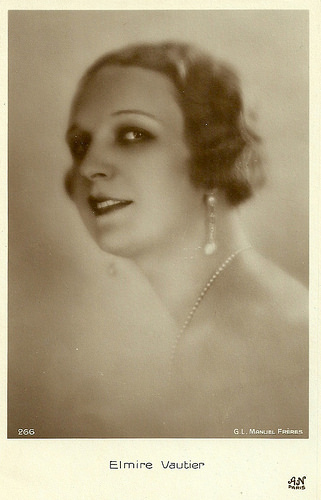
French postcard by A.N., Paris, no. 266. Photo: G.L. Manuel Frères.
Sources: Ciné-Artistes (French), Cinefil, Wikipedia (French), and .

French postcard by Editions Cinémagazine, no. 51. Photo: Studio Pathé.
An Illegitimate Child
Armandine Elmire Vautier was born in Grandchain, Eure, France in 1897.
She made her film debut in Sa gosse/Her Kid (1919), directed by Henri Desfontaines. It was the story about a woman from the countryside who moves to Paris after having an illegitimate child, but she does not like the capital and longs for her daughter.
From then on Vautier had a prolific career in French silent cinema, often paired with René Navarre , but also with Renée Sylvaire .
Memorable titles are Le roi de Camargue/The King of the Camargue (André Hugon, 1922), Judith (Georges Monca, Rose Pansini, 1922), the serial L'homme aux trois masques/The Man with Three Masks (Émile Keppens, René Navarre, 1922) with Gina Manès , Vidoq (Jean Kemm, 1923), Ferragus (Gaston Ravel, 1923) with British actor Stewart Rome , Jean Chouan (Luitz-Morat, 1925), Belphégor (Henri Desfontaines, 1927), and La tentation/Temptation (René Barberis, René Leprince, 1929).
In Le roi de Camargue Vautier, she plays Lisette, a girl who is in love with Renaud ( Charles de Rochefort ), the 'king' of the Camargue. When he falls for a dashing gypsy woman, she tries to drown herself.
In Judith she is a countess whose husband is suspected of murder, and in Vidoq she is Manon la blonde, wife of Vidoq ( René Navarre ) but now the mistress of a rich man.
In Ferragus she is the daughter of an ex-convict (Navarre), now leader of a powerful secret society. A young man (Lucien Dalsace) is interested in her, but her father fears the unmasking of the family reputation.

French postcard by Editions Filma in the series Les Vedettes du Cinéma, no. 10. Photo: Super-Film.

René Navarre. French postcard. Photo: DIX, Paris.
Dressed As A Ghost
One of Elmire Vautier's leading roles in the 1920s was that of Simone Desroches, who haunts the Louvre dressed as the ghost Belphégor, trying to steal from the museum. Eventually she is unmasked by the detective Chantecoq ( René Navarre ) and her own friend, the journalist Jacques Bellegarde (Lucien Dalsace).
In 1930 Vautier made the passage to sound film, playing in French productions shot at the Parisian Paramount studios. From 1931 and 1934 she was away from the screen for a while, and when she returned her parts had become smaller.
In the late 1930s and early 1940s she still acted in a few period pieces like Le patriote/The Mad Emperor (Maurice Tourneur, 1938) with Harry Baur , and Mam'zelle Bonaparte/Miss Bonaparte (Maurice Tourneur, 1942) starring Edwige Feuillère , but then her film career was over.
Elmire Vautier died in Livilliers, Val d'Oise, France in 1954. She was 56. For a time, she was married to René Navarre , but no exact dates are available.

French postcard by A.N., Paris, no. 266. Photo: G.L. Manuel Frères.
Sources: Ciné-Artistes (French), Cinefil, Wikipedia (French), and .
Published on July 16, 2016 22:00
July 15, 2016
Agnès Laurent
Beautiful French actress Agnès Laurent (1936-2010) featured in a dozen European sexploitation films of the late 1950s and early 1960s. She was touted as 'The New French sex kitten', a rival to Brigitte Bardot.
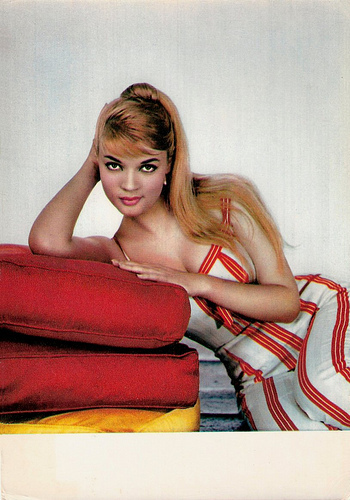
French postcard by Editions P.I., Paris, no. 1013. Photo: Sam Lévin.
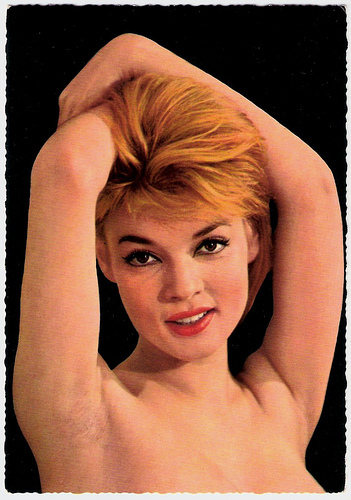
German postcard by Krüger, no. 902/233. Photo: Gérard Decaux.
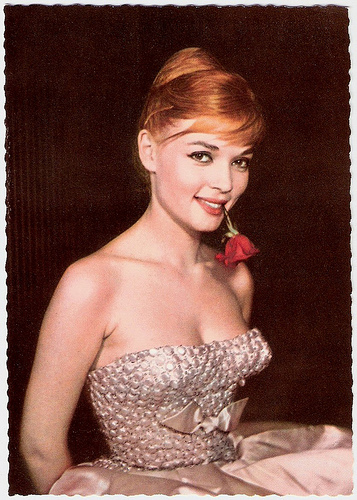
German postcard by Ufa (Universum-Film Aktiengesellschaft), Berlin-Tempelhof, no. CK-182. Retail price: 30 Pfg. Photo: Sam Lévin / Ufa.
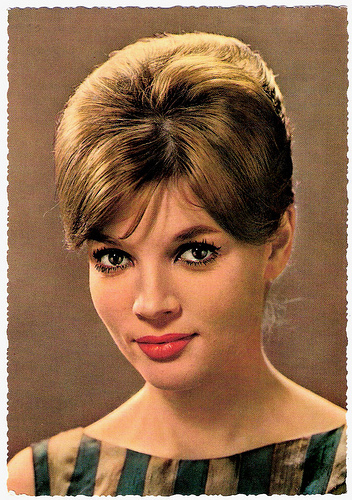
German postcard by Krüger, no. 902/77.
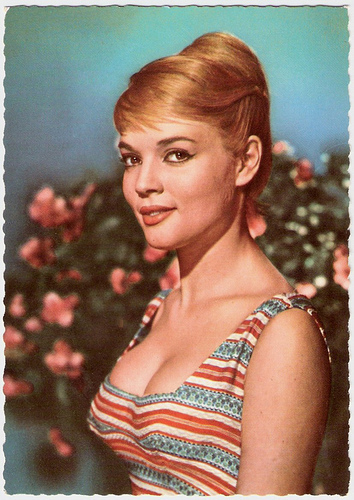
German postcard by Ufa (Universum-Film Aktiengesellschaft), Berlin-Tempelhof, no. CK-199. Retail price: 30 Pfg. Photo: Sam Lévin / Ufa.
Striptease
Agnès Laurent was born Josette Chouleur in Lyon, France in 1936 (according to Les Gens du Cinema , based on her birth certificate) or 1938 (according to CITWF ). After working for a few months as a secretary, she had some acting classes from Eve Francis and Charles Dullin .
She made her film début in the short film Axelle et son Clochard/Axelle and her Tramp (Pierre Foucaud, 1956). The film was produced by René Thévenet, who would also produce some of her later films. Her next stint was a small part in Mannequins de Paris/Mannequins of Paris (André Hunebelle, 1956) starring Madeleine Robinson and Ivan Desny .
In her following film she was already top-billed, Les Collegiennes/The Twilight Girls (André Hunebelle, 1956) about the turbulent emotions among girls on a regimented French girls' school. In the film also appeared a young Catherine Deneuve . In the sexploitation melodrama Marchands De Filles/Sellers Of Girls (Maurice Cloche, 1957) she gets involved with a white slavery racket. While on a ship to South America, she becomes engaged to a crewman, played by Georges Marchal , and then she tackles the syndicate head-on.
In the sex comedy Mademoiselle Striptease/The Nude Set (Pierre Foucaud, 1957), she played a spoiled young provincial girl who coerces her wealthy parents into sending her to Paris. In gay Paris, Agnes discovers the bohemian nightclubs where striptease has become so popular - in no time the timid country girl goes from spectator to performer.
Mark Deming calls it at AllMovie ‘a charming sexual frolic that features outstanding striptease and cabaret performances’. When Audubon Films released The Nude Set in 1961 in the US, the big selling point was Agnès Laurent. The film's sexy young star was touted by Audubon as 'The New French Sex Kitten'. She was hailed as a rival to Brigitte Bardot .
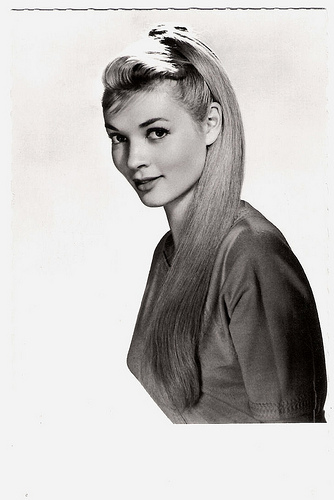
French postcard by Editions P.I., Paris, offered by Les Carbones Korès 'Carboplane', no. 896. Photo: Sam Lévin.
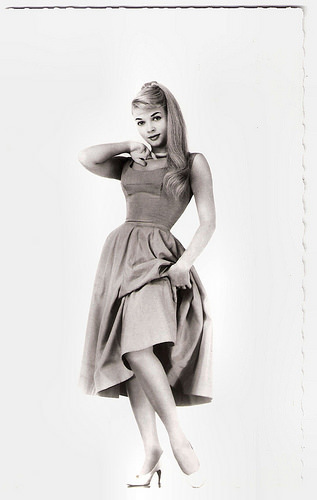
French postcard by Editions P.I., Paris, no. 935. Photo: Sam Lévin.
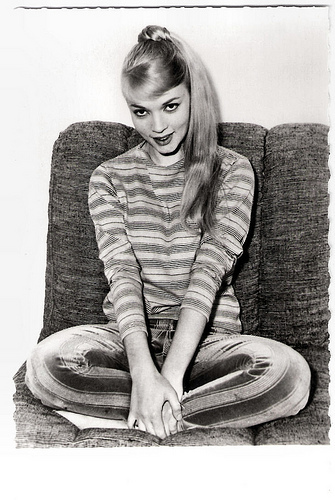
French postcard by Editions P.I., Paris, offered by Les Carbones Korès 'Carboplane', no. 964. Photo: Studio Vauclair.
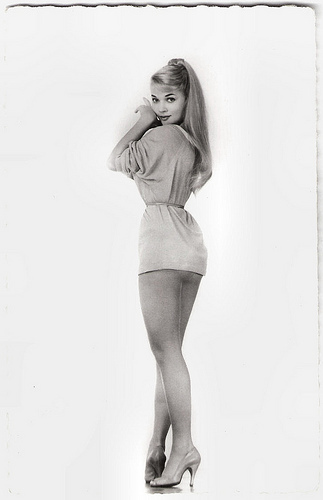
French postcard by Editions du Globe, Paris, no. 727. Photo: Sam Lévin.
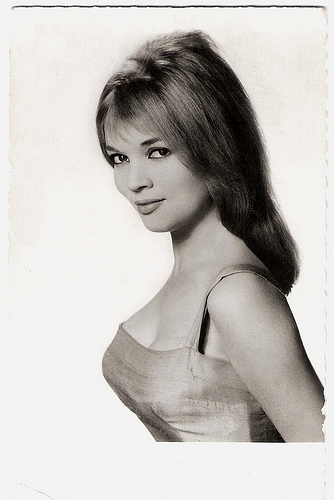
French postcard by Editions P.I., Paris, no. 1025. Photo: Sam Lévin.
Miniature Girl
1957 was a busy year for Agnès Laurent. She also appeared as Monette, the sexy assistant of scientist Prof. Jerome ( Jean Marais ) in the Sci-Fi comedy Un amour de poche/Girl in His Pocket (Pierre Kast, 1957).
The professor stumbles upon a formula that shrinks people. When his wife suspects that her husband is carrying on a romance with Monette (she's right), the naked Monette hides herself by drinking the potion and shrinks to 3 inches tall. The professor keeps her in his pocket until he can find an antidote. The film was based on The Diminishing Draft, a short story by Waldemar Kaempfert from 1918.
The following year she appeared in the German-French war film Die grünen Teufel von Monte Cassino/The green Devils of Monte Cassino (Harald Reinl, 1958) featuring Joachim Fuchsberger.
In 1959, Lauerent starred in the Spanish production Un mundo para mí/Soft Skin and Black Lace (José Antonio de la Loma, 1959). Scenes were later edited in Radley Metzger’s compilation film Dictionary of Sex (1964).
In Spain she also appeared in Altas variedades/The Big Show (Francisco Rovira Beleta, 1960) opposite Christian Marquand, and in Italy she made the adventure film La notte del grande assalto/The Night of the Great Attack (Giuseppe Maria Scotese, 1960).
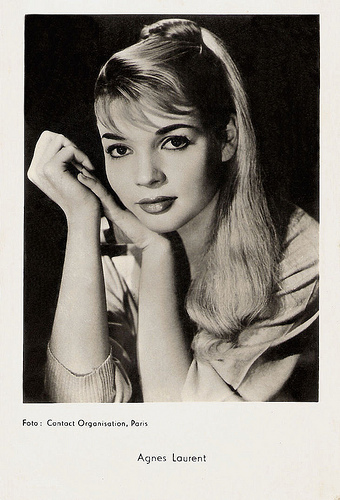
French postcard by Editions P.I., Paris, no. FK 4138. Photo: Contact Organisation, Paris / Ufa, Berlin-Tempelhof.
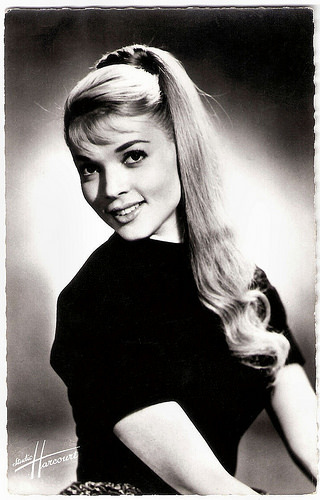
French postcard by Editions du Globe, Paris, no. 692 Photo: Studio Harcourt.
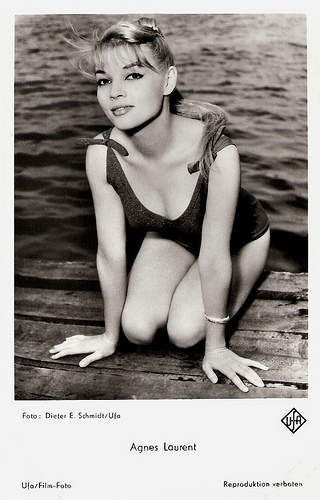
German postcard by Ufa. Photo: Dieter E. Schmidt / Ufa.
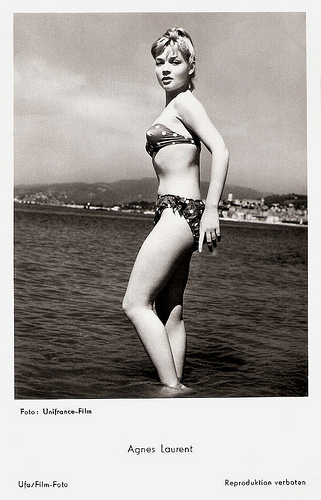
German postcard by Ufa. Photo: Unifrance-Film.
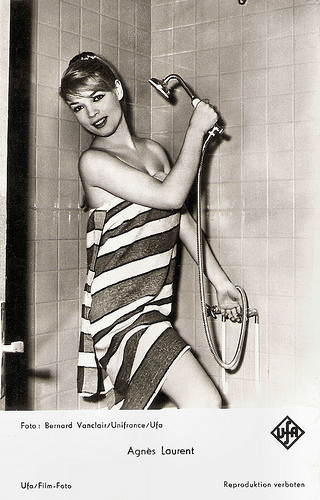
German postcard by UFA, Berlin-Tempelhof, no. FK 4503. Photo: Bernard Vauclair / Unifrance / Ufa.
Plenty of Ooh la la!
In 1960 Agnès Laurent moved over to England to appear in the British comedy A French Mistress (Roy Boulting, 1960). She played a gorgeous new French language teacher on a traditional British boys' school, who causes countless crushes of the young lads and their profs. Jenny Evans at IMDb calls it ‘a breezy comedy with plenty of ooh la la!’.
The next year she appeared in another British comedy Mary Had A Little... (Edward Buzzell, 1961). This was Britain's first sex comedy, according to David McGillivray in his history of the British sex film, Doing Rude Things.
In 1961 she also appeared opposite Jean-Paul Belmondo in the episode Lauzun of the anthology film Amours célèbres/Famous Love Affairs (Michel Boisrond a.o., 1961).
Later she worked for television in TV films like Peril au Paradis/Peril in the Paradise (Edmond T. Greville, 1964).
Laurent then abandoned acting and wrote some crime novels, including Au cœur de ma nuit (In the heart of my night, 1970) and Requiem pour un fantôme (Requiem for a ghost, 1973).
In 2010, Agnés Laurent passed away in Grenoble, France. She was 74.
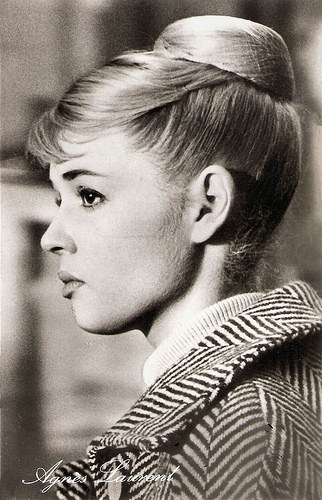
East-German postcard by VEB Progress Film-Vertrieb, Berlin, no. 1103, 1959. Photo: publicity still for Péché de jeunesse/Sins of Youth (Louis Duchesne, 1958).
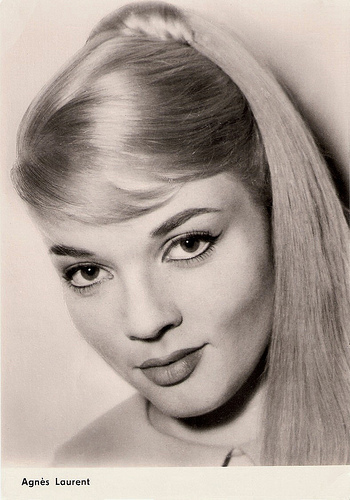
East-German postcard by VEB progress Film-Vertrieb, Berlin, no. 1105, 1962. Photo: Progress.
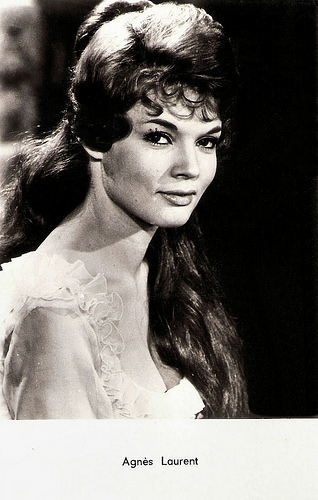
French postcard by Editions P.I., Paris, offered by Les Carbones Korès 'Carboplane', no. 1122. Photo: Unidex. Publicity still for Amours célèbres/Famous Love Affairs (Michel Boisrond, 1961).
This clip is a special feature that describes the making of the American version of Les Collegiennes (1956), The Twilight Girls. This film broke new ground in the country's legal definition of pornography and was the cause of a landmark judicial decision in late-1950s New York's censorship statutes. Source: Georgina Spelvin (YouTube).
American trailer for Marchands De Filles/Sellers Of Girls (1957). Source: SomethingWeirdDotCom (YouTube).
Sources: Mark Deming (AllMovie), Yvan Foucart (Le coin du cinéphage - French), CITWF, Les gens du cinema (French), Wikipedia (Dutch) and .

French postcard by Editions P.I., Paris, no. 1013. Photo: Sam Lévin.

German postcard by Krüger, no. 902/233. Photo: Gérard Decaux.

German postcard by Ufa (Universum-Film Aktiengesellschaft), Berlin-Tempelhof, no. CK-182. Retail price: 30 Pfg. Photo: Sam Lévin / Ufa.

German postcard by Krüger, no. 902/77.

German postcard by Ufa (Universum-Film Aktiengesellschaft), Berlin-Tempelhof, no. CK-199. Retail price: 30 Pfg. Photo: Sam Lévin / Ufa.
Striptease
Agnès Laurent was born Josette Chouleur in Lyon, France in 1936 (according to Les Gens du Cinema , based on her birth certificate) or 1938 (according to CITWF ). After working for a few months as a secretary, she had some acting classes from Eve Francis and Charles Dullin .
She made her film début in the short film Axelle et son Clochard/Axelle and her Tramp (Pierre Foucaud, 1956). The film was produced by René Thévenet, who would also produce some of her later films. Her next stint was a small part in Mannequins de Paris/Mannequins of Paris (André Hunebelle, 1956) starring Madeleine Robinson and Ivan Desny .
In her following film she was already top-billed, Les Collegiennes/The Twilight Girls (André Hunebelle, 1956) about the turbulent emotions among girls on a regimented French girls' school. In the film also appeared a young Catherine Deneuve . In the sexploitation melodrama Marchands De Filles/Sellers Of Girls (Maurice Cloche, 1957) she gets involved with a white slavery racket. While on a ship to South America, she becomes engaged to a crewman, played by Georges Marchal , and then she tackles the syndicate head-on.
In the sex comedy Mademoiselle Striptease/The Nude Set (Pierre Foucaud, 1957), she played a spoiled young provincial girl who coerces her wealthy parents into sending her to Paris. In gay Paris, Agnes discovers the bohemian nightclubs where striptease has become so popular - in no time the timid country girl goes from spectator to performer.
Mark Deming calls it at AllMovie ‘a charming sexual frolic that features outstanding striptease and cabaret performances’. When Audubon Films released The Nude Set in 1961 in the US, the big selling point was Agnès Laurent. The film's sexy young star was touted by Audubon as 'The New French Sex Kitten'. She was hailed as a rival to Brigitte Bardot .

French postcard by Editions P.I., Paris, offered by Les Carbones Korès 'Carboplane', no. 896. Photo: Sam Lévin.

French postcard by Editions P.I., Paris, no. 935. Photo: Sam Lévin.

French postcard by Editions P.I., Paris, offered by Les Carbones Korès 'Carboplane', no. 964. Photo: Studio Vauclair.

French postcard by Editions du Globe, Paris, no. 727. Photo: Sam Lévin.

French postcard by Editions P.I., Paris, no. 1025. Photo: Sam Lévin.
Miniature Girl
1957 was a busy year for Agnès Laurent. She also appeared as Monette, the sexy assistant of scientist Prof. Jerome ( Jean Marais ) in the Sci-Fi comedy Un amour de poche/Girl in His Pocket (Pierre Kast, 1957).
The professor stumbles upon a formula that shrinks people. When his wife suspects that her husband is carrying on a romance with Monette (she's right), the naked Monette hides herself by drinking the potion and shrinks to 3 inches tall. The professor keeps her in his pocket until he can find an antidote. The film was based on The Diminishing Draft, a short story by Waldemar Kaempfert from 1918.
The following year she appeared in the German-French war film Die grünen Teufel von Monte Cassino/The green Devils of Monte Cassino (Harald Reinl, 1958) featuring Joachim Fuchsberger.
In 1959, Lauerent starred in the Spanish production Un mundo para mí/Soft Skin and Black Lace (José Antonio de la Loma, 1959). Scenes were later edited in Radley Metzger’s compilation film Dictionary of Sex (1964).
In Spain she also appeared in Altas variedades/The Big Show (Francisco Rovira Beleta, 1960) opposite Christian Marquand, and in Italy she made the adventure film La notte del grande assalto/The Night of the Great Attack (Giuseppe Maria Scotese, 1960).

French postcard by Editions P.I., Paris, no. FK 4138. Photo: Contact Organisation, Paris / Ufa, Berlin-Tempelhof.

French postcard by Editions du Globe, Paris, no. 692 Photo: Studio Harcourt.

German postcard by Ufa. Photo: Dieter E. Schmidt / Ufa.

German postcard by Ufa. Photo: Unifrance-Film.

German postcard by UFA, Berlin-Tempelhof, no. FK 4503. Photo: Bernard Vauclair / Unifrance / Ufa.
Plenty of Ooh la la!
In 1960 Agnès Laurent moved over to England to appear in the British comedy A French Mistress (Roy Boulting, 1960). She played a gorgeous new French language teacher on a traditional British boys' school, who causes countless crushes of the young lads and their profs. Jenny Evans at IMDb calls it ‘a breezy comedy with plenty of ooh la la!’.
The next year she appeared in another British comedy Mary Had A Little... (Edward Buzzell, 1961). This was Britain's first sex comedy, according to David McGillivray in his history of the British sex film, Doing Rude Things.
In 1961 she also appeared opposite Jean-Paul Belmondo in the episode Lauzun of the anthology film Amours célèbres/Famous Love Affairs (Michel Boisrond a.o., 1961).
Later she worked for television in TV films like Peril au Paradis/Peril in the Paradise (Edmond T. Greville, 1964).
Laurent then abandoned acting and wrote some crime novels, including Au cœur de ma nuit (In the heart of my night, 1970) and Requiem pour un fantôme (Requiem for a ghost, 1973).
In 2010, Agnés Laurent passed away in Grenoble, France. She was 74.

East-German postcard by VEB Progress Film-Vertrieb, Berlin, no. 1103, 1959. Photo: publicity still for Péché de jeunesse/Sins of Youth (Louis Duchesne, 1958).

East-German postcard by VEB progress Film-Vertrieb, Berlin, no. 1105, 1962. Photo: Progress.

French postcard by Editions P.I., Paris, offered by Les Carbones Korès 'Carboplane', no. 1122. Photo: Unidex. Publicity still for Amours célèbres/Famous Love Affairs (Michel Boisrond, 1961).
This clip is a special feature that describes the making of the American version of Les Collegiennes (1956), The Twilight Girls. This film broke new ground in the country's legal definition of pornography and was the cause of a landmark judicial decision in late-1950s New York's censorship statutes. Source: Georgina Spelvin (YouTube).
American trailer for Marchands De Filles/Sellers Of Girls (1957). Source: SomethingWeirdDotCom (YouTube).
Sources: Mark Deming (AllMovie), Yvan Foucart (Le coin du cinéphage - French), CITWF, Les gens du cinema (French), Wikipedia (Dutch) and .
Published on July 15, 2016 22:00
July 14, 2016
EFSP's Dazzling Dozen: Little Angels and Backfisches
In 1914 'Little Mary' Pickford became the most popular actress in America, if not the world. During the silent era, she was beloved for her beauty and charm. Even when she was an adult, Pickford often appeared on screen in young girl roles. In Europe many film stars followed in her footsteps. In the 1920s, the modern girl became boyish yet feminine - short hair, gawky limbs, a young flapper on the edge of sexuality, affectionately known in Germany as a 'Backfisch' (literally meaning fish to fry).
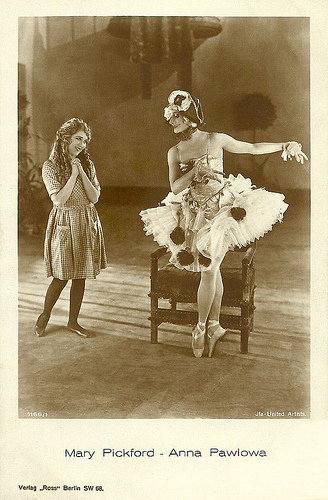
German postcard by Ross Verlag, Berlin, no. 1166/1, 1927-1928. Photo: United Artists.
Mary Pickford (1892-1972) was known as 'America’s sweetheart.' She was a founder of United Artists and helped to establish the Academy.
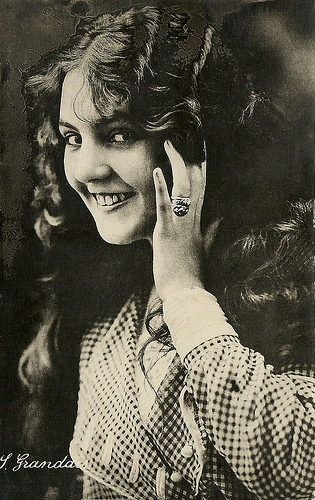
Vintage postcard. Collection: Didier Hanson.
Suzanne Grandais (1893-1920) was the most beautiful and sophisticated actress of the French silent cinema. Her nickname was 'the French Mary Pickford' because of her angel face and blond hair.
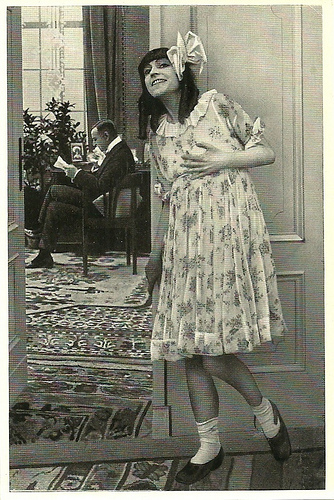
German small photo for the album by Dr. Oskar Kalbus, Vom Werden deutscher Filmkunst, Vol. I, Der Stummfilm (Cigaretten Bilderdienst, 1935). Asta Nielsen in Engelein (Urban Gad, 1914).
Danish silent film actress Asta Nielsen (1881-1972), was one of the most popular leading ladies of the 1910s and one of the first international film stars.
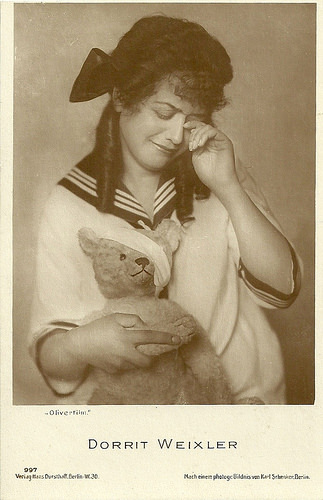
German postcard by Verlag Hans Dursthoff, Berlin, no. 897. Photo: Karl Schenker, Berlin / Oliver Film.
German silent film actress Dorrit Weixler (1892-1916) anticipated such better known comedy stars of the German cinema as Ossi Oswalda and Anny Ondra. The career of the bright and light comedienne was like a candle burning on both sides.

German postcard by Photochemie, Berlin, no. K. 286. Photo: Alard Walten, Berlin.
Ossi Oswalda (1895-1947) was one of the most popular comediennes of the German silent cinema.
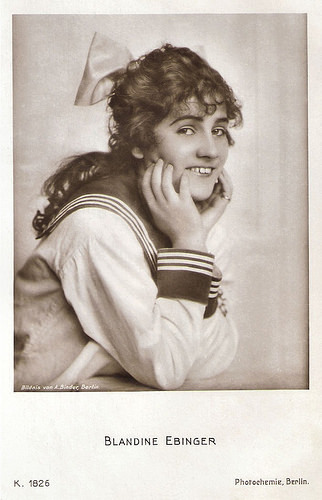
German postcard by Photochemie, Berlin, no. K. 1826. Photo: Alex Binder, Berlin.
Blandine Ebinger (1899-1993) was a German cabaret singer and actress. Her cinema career continued for seventy (70!) years.
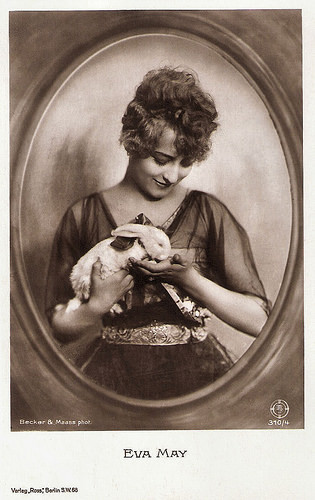
German postcard by Ross Verlag, Berlin, no. 310/4 1919-1924. Photo: Becker & Maass.
Eva May (1902-1924) was the daughter of film star Mia May and producer Joe May. It was only natural that she would follow suit. She became ‘everybody’s darling’ but in 1924 she committed suicide.
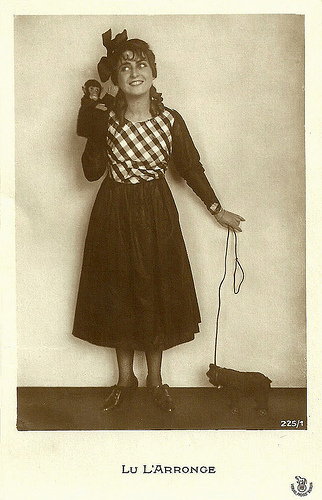
German postcard by Rotophot in the Film Sterne series, no. 225/1. Ca. 1919.
Little is known about Lu L'Arronge (1902-1991), who was a star of the German silent cinema, just after the First World War. The actress, who specialised in playing high-spirited teenagers, had her own production company with which she produced several films.
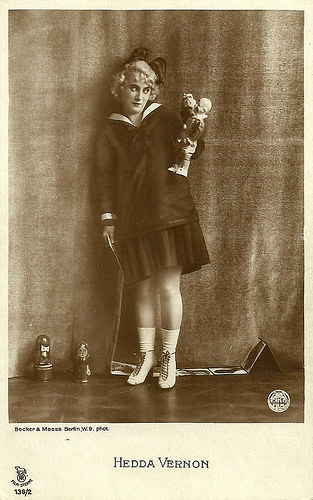
German postcard in the Film Sterne series by Becker & Maass, Berlin, no. 138/2. Photo: Eiko Film.
German actress, writer and producer Hedda Vernon (1866-?) appeared in more than 60 films of the early silent period. During the 1910s she was such a popular film star that she got her own Hedda Vernon serial.
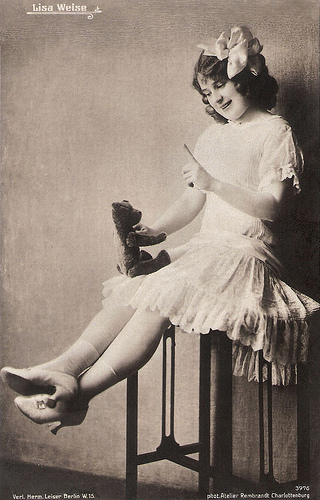
German postcard by Verlag Hermann Leiser, Berlin Wilm., no. 3976. Photo: Rembrandt, Charlottenburg.
German actress Lisa Weise (?-1952) starred in silent films of the 1910s. Most of her films were directed by Friedrich Zelnik and often her film partner was Karl Beckersachs.
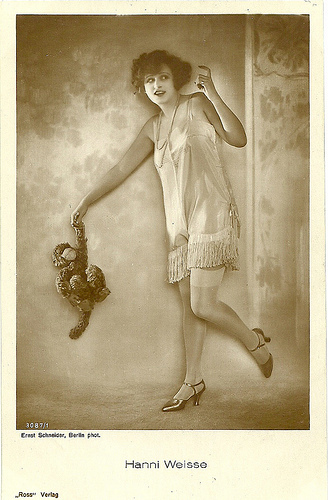
German postcard by Ross Verlag, no. 3087/1, 1928-1929. Photo: Ernst Schneider, Berlin.
Hanni Weisse (1892-1967) belonged to the great film divas of the early German silent film. She was able to maintain her stardom till the late 1920s and then still could play temperamental teenagers.
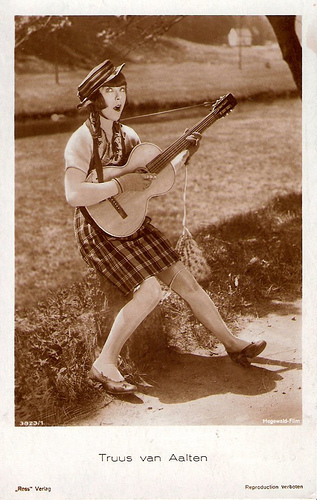
German postcard by Ross Verlag, no. 3823/1, 1928-1929. Photo: Hegewald Film. Collection: Egbert Barten.
Dutch film star Truus van Aalten (1910-1999) made 29 films in the 1920s and 1930s, and only one of them in the Netherlands. She was a typical 'Backfisch' of the late Weimar cinema. Because of her informal acting and her humour, Truus's nickname in Germany became 'die kleine holländische Käse' (the Little Dutch Cheese).
This is a post for Postcard Friendship Friday, hosted by Beth at the The Best Hearts are Crunchy. You can visit her by clicking on the button below.


German postcard by Ross Verlag, Berlin, no. 1166/1, 1927-1928. Photo: United Artists.
Mary Pickford (1892-1972) was known as 'America’s sweetheart.' She was a founder of United Artists and helped to establish the Academy.

Vintage postcard. Collection: Didier Hanson.
Suzanne Grandais (1893-1920) was the most beautiful and sophisticated actress of the French silent cinema. Her nickname was 'the French Mary Pickford' because of her angel face and blond hair.

German small photo for the album by Dr. Oskar Kalbus, Vom Werden deutscher Filmkunst, Vol. I, Der Stummfilm (Cigaretten Bilderdienst, 1935). Asta Nielsen in Engelein (Urban Gad, 1914).
Danish silent film actress Asta Nielsen (1881-1972), was one of the most popular leading ladies of the 1910s and one of the first international film stars.

German postcard by Verlag Hans Dursthoff, Berlin, no. 897. Photo: Karl Schenker, Berlin / Oliver Film.
German silent film actress Dorrit Weixler (1892-1916) anticipated such better known comedy stars of the German cinema as Ossi Oswalda and Anny Ondra. The career of the bright and light comedienne was like a candle burning on both sides.

German postcard by Photochemie, Berlin, no. K. 286. Photo: Alard Walten, Berlin.
Ossi Oswalda (1895-1947) was one of the most popular comediennes of the German silent cinema.

German postcard by Photochemie, Berlin, no. K. 1826. Photo: Alex Binder, Berlin.
Blandine Ebinger (1899-1993) was a German cabaret singer and actress. Her cinema career continued for seventy (70!) years.

German postcard by Ross Verlag, Berlin, no. 310/4 1919-1924. Photo: Becker & Maass.
Eva May (1902-1924) was the daughter of film star Mia May and producer Joe May. It was only natural that she would follow suit. She became ‘everybody’s darling’ but in 1924 she committed suicide.

German postcard by Rotophot in the Film Sterne series, no. 225/1. Ca. 1919.
Little is known about Lu L'Arronge (1902-1991), who was a star of the German silent cinema, just after the First World War. The actress, who specialised in playing high-spirited teenagers, had her own production company with which she produced several films.

German postcard in the Film Sterne series by Becker & Maass, Berlin, no. 138/2. Photo: Eiko Film.
German actress, writer and producer Hedda Vernon (1866-?) appeared in more than 60 films of the early silent period. During the 1910s she was such a popular film star that she got her own Hedda Vernon serial.

German postcard by Verlag Hermann Leiser, Berlin Wilm., no. 3976. Photo: Rembrandt, Charlottenburg.
German actress Lisa Weise (?-1952) starred in silent films of the 1910s. Most of her films were directed by Friedrich Zelnik and often her film partner was Karl Beckersachs.

German postcard by Ross Verlag, no. 3087/1, 1928-1929. Photo: Ernst Schneider, Berlin.
Hanni Weisse (1892-1967) belonged to the great film divas of the early German silent film. She was able to maintain her stardom till the late 1920s and then still could play temperamental teenagers.

German postcard by Ross Verlag, no. 3823/1, 1928-1929. Photo: Hegewald Film. Collection: Egbert Barten.
Dutch film star Truus van Aalten (1910-1999) made 29 films in the 1920s and 1930s, and only one of them in the Netherlands. She was a typical 'Backfisch' of the late Weimar cinema. Because of her informal acting and her humour, Truus's nickname in Germany became 'die kleine holländische Käse' (the Little Dutch Cheese).
This is a post for Postcard Friendship Friday, hosted by Beth at the The Best Hearts are Crunchy. You can visit her by clicking on the button below.

Published on July 14, 2016 22:00
July 13, 2016
Chelo Alonso
Former Cuban actress, dancer and sex-symbol Chelo Alonso (1933) was a star in the Italian cinema of the late 1950s and early 1960s. In several sword and sandal epics she played femme fatales with fiery tempers and she did sensual dance scenes, mixing Afro-Cuban rhythms with ‘bump and grind’. In the DVD era, the ‘Cuban H-bomb’ became a cult heroine for many international B-film buffs.

German postcard by Krüger, no. 902/118.
Sensual, Exotic Style
Darkly stunning Chelo Alonso was born Isabella Garcia in 1933 in Central Lugareño, Cuba, to a Cuban father and a Mexican mother. At a very young age, it became evident that Isabella possessed a great talent for dancing. At 17, she began performing seriously in Havana and soon earned notoriety at Cuba's National Theatre for her sensual, exotic style.
As Chelo Alonso, she toured many cities all over the world, including Havana, Puerto Rico, St. Domingo, Haiti, Miami, New Orleans, New York (Broadway), and finally she arrived in Paris in 1957.
At the Folies Bergère, she was the main star and billed as the ‘new Josephine Baker ’, who had become famous at the Folies more than 30 years before her. Alonso was billed as the ‘Cuban H-Bomb’, and mixed her native Latin Rhythms such as Mambo and Son, and fused them with the classic ‘bump and grind’.
Soon her sensual beauty and allure were discovered for the cinema. She went to the Mecca of the European film industry at the time, Rome. Many of Alonso's later films were Peplums, Italian sword and sandal films in the style of Le Fatiche di Ercole/Hercules (Pietro Francisci, 1958). This box office sensation had starred bodybuilder Steve Reeves and had created a wildly popular new film genre. Hercules paved the way for several Italian B-films attempting to emulate its success. These films required exotic talent, and Alonso's dark beauty fit the bill.
Chelo Alonso was first noticed internationally as Erica the slave dancer and conspirator in Nel segno di Roma/Sign of the Gladiator (Guido Brignone, 1959), which starred Anita Ekberg and Georges Marchal. Alonso’s billing was upped due to a particularly erotic dance number, and she became the second female lead. Her picture and name on the posters became even more prominent than either of the two stars, reportedly much to Anita Ekberg ’s displeasure.
That year Alonso also played a princess opposite Lex Barker and Massimo Serrato in La Scimitarra del Saraceno/The Pirate and the Slave Girl (Piero Pierotti, 1959), and she starred with Steve Reeves himself in Il Terrore dei barbari/Goliath and the Barbarians (Carlo Campogalliani, 1959). Her part in the latter film earned Alonso the award of ‘Italian Cinema's Female Discovery’.
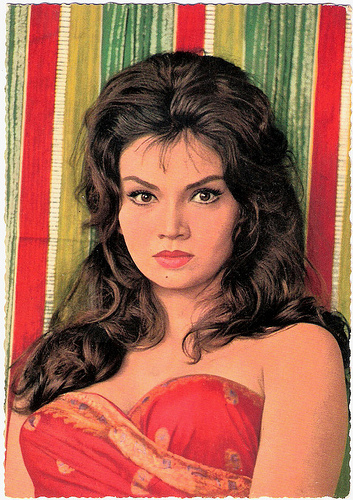
German postcard by Krüger, no. 902/196. Photo: Gérard Decaux.
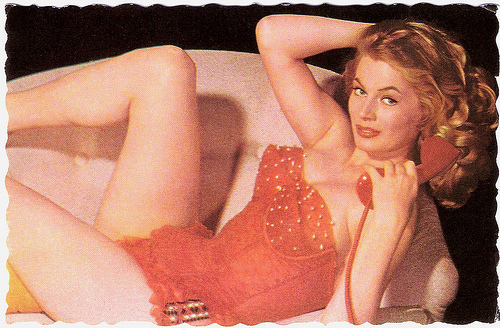
Anita Ekberg . French postcard by De Marchi Frères, Marseille.
Che Guevara's Invitation
With her volcanic temperament, highly distinctive cheekbones and wild mane of dark hair, Chelo Alonso went on to star in a dozen Peplums and other adventure films. She charmed muscleman co-stars like Steve Reeves , Mark Forest, Jacques Sernas , Rik Battaglia and Gordon Mitchell in such films as Maciste nella valle dei re/Maciste the Mighty (Carlo Campogalliani, 1960), Terrore della maschera rossa/Terror of the Red Mask (Luigi Capuano, 1960), La regina dei tartari/The Queen of the Tartars (Sergio Grieco, 1960), and Morgan il pirata/Morgan the Pirate (André De Toth, Primo Zeglio, 1960).
That same year she also filmed a comedy, Gastone (Mario Bonnard, 1960), alongside two giants of the Italian cinema, Alberto Sordi and Vittoria De Sica . A year later, she married Aldo Pomilia, a production manager and producer whom she had met while working on Morgan the Pirate. She later bore him son Aldino.
Chelo reportedly refused Che Guevara's invitation to come back to Havana during the revolution, preferring to remain in Rome. Following Quattro notti don Alba/Desert War (Luigi Filippo D'Amico, 1962), Alonso left film for a time to turn her attention to television. She even took part in a cooking show, where the public could witness her preparing a typical Cuban meal of rice and chicken.
She did not return to the screen until the classic Spaghetti Western Il buono, il brutto, il cattivo/The Good, the Bad, and the Ugly (Sergio Leone, 1966). Ironically, in her most widely distributed film she only played a small, mute role. She played the unfortunate Mexican wife of Stevens (Antonio Casas) murdered by Lee Van Cleef in one of the film’s most striking sequences.
Then followed supporting parts in two other interesting Spaghetti Westerns. The first was the underrated Corri uomo corri/Big Gundown 2 (Sergio Sollima, 1968) starring Tomas Milian . Her final film was the obscure La Notte dei serpenti/Night of the Serpent (Giulio Petroni, 1970).
After the death of her producer-husband in 1986, Alonso moved to the city of Siena in Tuscany, Italy. She opened a small cat-breeding farm, which became a luxurious four-star hotel.
Chelo Alonso’s film career was brief, but we do agree with Ben Chenier at Cult Sirens : “She was in no more than 20 films but had she played in only one, we still couldn't forget her. (...) One of the most astounding beauty of her time (or any time, in my view), Chelo Alonso lit up the screen every time she appeared before a camera. That gorgeous figure, those amazing cheekbones, that heavy mane of hair... all elements to nominate her at the Pantheon of Immortal Movie Goddesses”.
Trailer Il Terrore dei barbari/Goliath and the Barbarians (1959). Source: Sword and Sandal FLIX (YouTube).
The dance scene from Nel segno di Roma/Sign of the Gladiator (1959) Source: Peplum TV (YouTube).
Sources: Ben Chenier (Cult Sirens), (IMDb), Matt Blake (The Wild Eye), Wikipedia, and .

German postcard by Krüger, no. 902/118.
Sensual, Exotic Style
Darkly stunning Chelo Alonso was born Isabella Garcia in 1933 in Central Lugareño, Cuba, to a Cuban father and a Mexican mother. At a very young age, it became evident that Isabella possessed a great talent for dancing. At 17, she began performing seriously in Havana and soon earned notoriety at Cuba's National Theatre for her sensual, exotic style.
As Chelo Alonso, she toured many cities all over the world, including Havana, Puerto Rico, St. Domingo, Haiti, Miami, New Orleans, New York (Broadway), and finally she arrived in Paris in 1957.
At the Folies Bergère, she was the main star and billed as the ‘new Josephine Baker ’, who had become famous at the Folies more than 30 years before her. Alonso was billed as the ‘Cuban H-Bomb’, and mixed her native Latin Rhythms such as Mambo and Son, and fused them with the classic ‘bump and grind’.
Soon her sensual beauty and allure were discovered for the cinema. She went to the Mecca of the European film industry at the time, Rome. Many of Alonso's later films were Peplums, Italian sword and sandal films in the style of Le Fatiche di Ercole/Hercules (Pietro Francisci, 1958). This box office sensation had starred bodybuilder Steve Reeves and had created a wildly popular new film genre. Hercules paved the way for several Italian B-films attempting to emulate its success. These films required exotic talent, and Alonso's dark beauty fit the bill.
Chelo Alonso was first noticed internationally as Erica the slave dancer and conspirator in Nel segno di Roma/Sign of the Gladiator (Guido Brignone, 1959), which starred Anita Ekberg and Georges Marchal. Alonso’s billing was upped due to a particularly erotic dance number, and she became the second female lead. Her picture and name on the posters became even more prominent than either of the two stars, reportedly much to Anita Ekberg ’s displeasure.
That year Alonso also played a princess opposite Lex Barker and Massimo Serrato in La Scimitarra del Saraceno/The Pirate and the Slave Girl (Piero Pierotti, 1959), and she starred with Steve Reeves himself in Il Terrore dei barbari/Goliath and the Barbarians (Carlo Campogalliani, 1959). Her part in the latter film earned Alonso the award of ‘Italian Cinema's Female Discovery’.

German postcard by Krüger, no. 902/196. Photo: Gérard Decaux.

Anita Ekberg . French postcard by De Marchi Frères, Marseille.
Che Guevara's Invitation
With her volcanic temperament, highly distinctive cheekbones and wild mane of dark hair, Chelo Alonso went on to star in a dozen Peplums and other adventure films. She charmed muscleman co-stars like Steve Reeves , Mark Forest, Jacques Sernas , Rik Battaglia and Gordon Mitchell in such films as Maciste nella valle dei re/Maciste the Mighty (Carlo Campogalliani, 1960), Terrore della maschera rossa/Terror of the Red Mask (Luigi Capuano, 1960), La regina dei tartari/The Queen of the Tartars (Sergio Grieco, 1960), and Morgan il pirata/Morgan the Pirate (André De Toth, Primo Zeglio, 1960).
That same year she also filmed a comedy, Gastone (Mario Bonnard, 1960), alongside two giants of the Italian cinema, Alberto Sordi and Vittoria De Sica . A year later, she married Aldo Pomilia, a production manager and producer whom she had met while working on Morgan the Pirate. She later bore him son Aldino.
Chelo reportedly refused Che Guevara's invitation to come back to Havana during the revolution, preferring to remain in Rome. Following Quattro notti don Alba/Desert War (Luigi Filippo D'Amico, 1962), Alonso left film for a time to turn her attention to television. She even took part in a cooking show, where the public could witness her preparing a typical Cuban meal of rice and chicken.
She did not return to the screen until the classic Spaghetti Western Il buono, il brutto, il cattivo/The Good, the Bad, and the Ugly (Sergio Leone, 1966). Ironically, in her most widely distributed film she only played a small, mute role. She played the unfortunate Mexican wife of Stevens (Antonio Casas) murdered by Lee Van Cleef in one of the film’s most striking sequences.
Then followed supporting parts in two other interesting Spaghetti Westerns. The first was the underrated Corri uomo corri/Big Gundown 2 (Sergio Sollima, 1968) starring Tomas Milian . Her final film was the obscure La Notte dei serpenti/Night of the Serpent (Giulio Petroni, 1970).
After the death of her producer-husband in 1986, Alonso moved to the city of Siena in Tuscany, Italy. She opened a small cat-breeding farm, which became a luxurious four-star hotel.
Chelo Alonso’s film career was brief, but we do agree with Ben Chenier at Cult Sirens : “She was in no more than 20 films but had she played in only one, we still couldn't forget her. (...) One of the most astounding beauty of her time (or any time, in my view), Chelo Alonso lit up the screen every time she appeared before a camera. That gorgeous figure, those amazing cheekbones, that heavy mane of hair... all elements to nominate her at the Pantheon of Immortal Movie Goddesses”.
Trailer Il Terrore dei barbari/Goliath and the Barbarians (1959). Source: Sword and Sandal FLIX (YouTube).
The dance scene from Nel segno di Roma/Sign of the Gladiator (1959) Source: Peplum TV (YouTube).
Sources: Ben Chenier (Cult Sirens), (IMDb), Matt Blake (The Wild Eye), Wikipedia, and .
Published on July 13, 2016 22:00
Paul van Yperen's Blog
- Paul van Yperen's profile
- 13 followers
Paul van Yperen isn't a Goodreads Author
(yet),
but they
do have a blog,
so here are some recent posts imported from
their feed.



